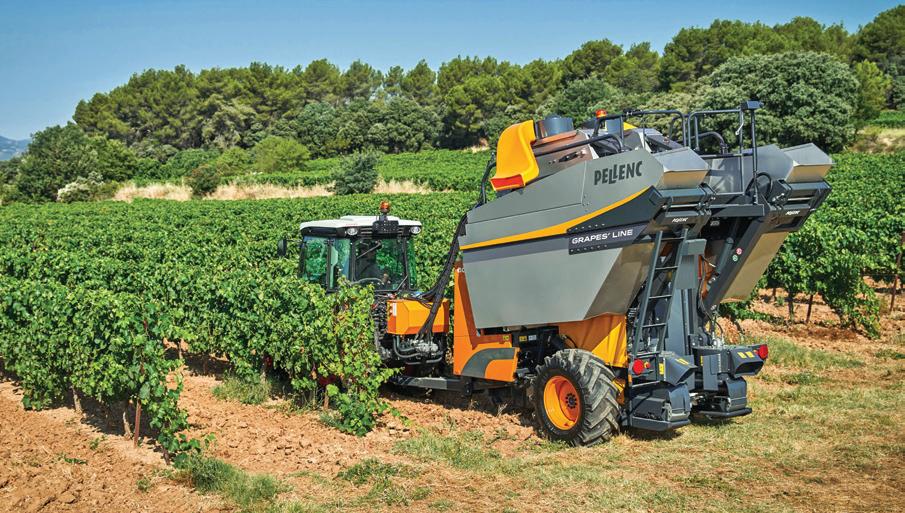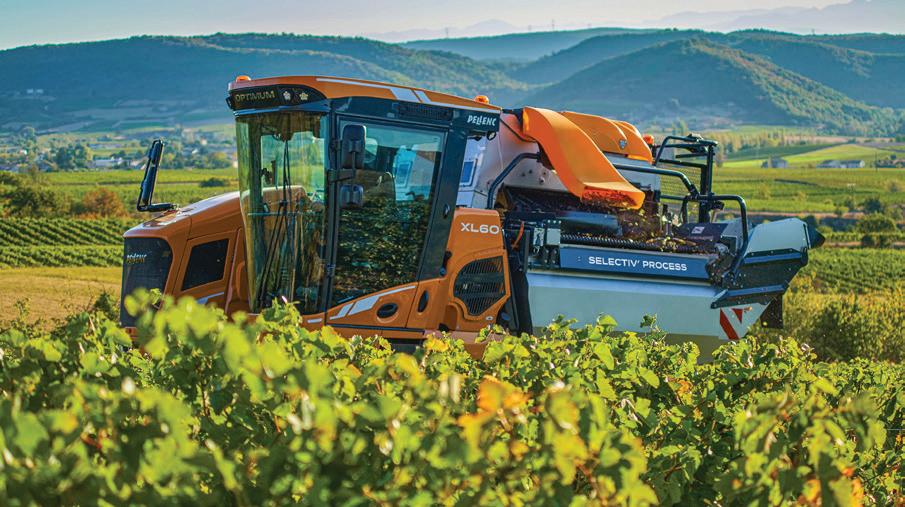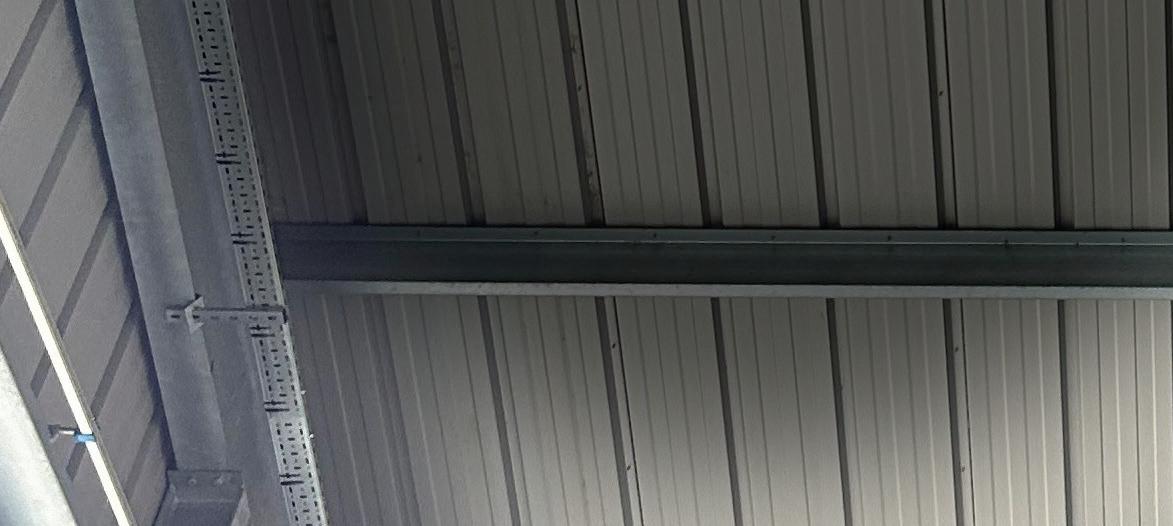


















Dispelling myths and revealing endless possibilities at a Yorkshire vineyard

&



Tanks for everything
Cutting-edge technology at collaborative venture

WineGB trade and press tasting







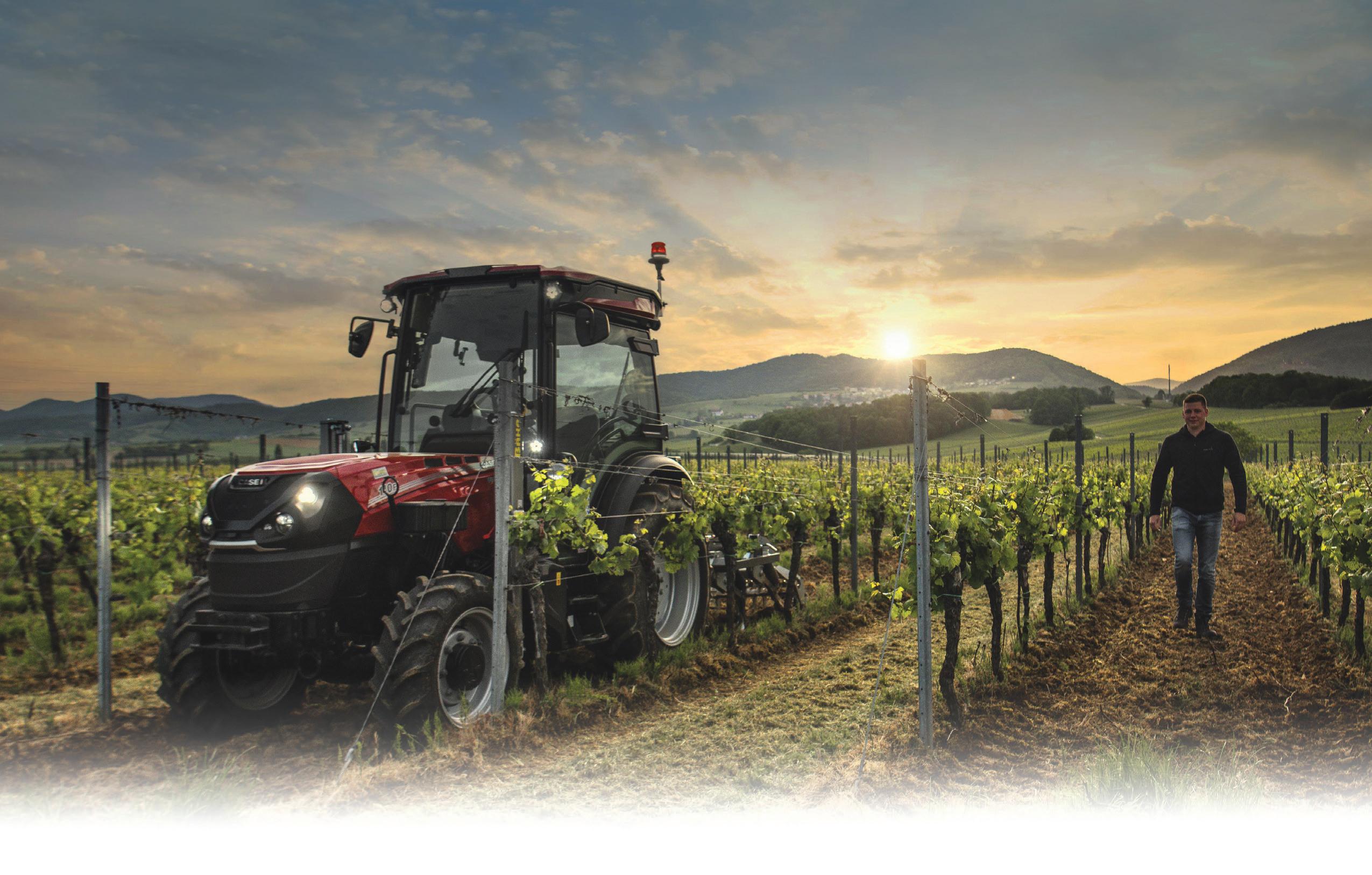

Vertical exhaust with shield, 32 x 16 ActiveDrive 2 transmission, 3 speed pto with ground speed, 80L + 36L dual hydraulic pump, 3 x rear remote valves and 2 x mid mount valves with

ow diverters, cat 2 drawbar, premium air seat, BlueCab ltration with AC, high mounted road lights, 360/70R26 adjustable rear wheels/tyres, 280/70R16 adjustable front wheels/tyres, dynamic front fenders, halogen light pack.
£50,000. 1 + 2 payments of £10,319*

QUANTUM 80N. 91197659 Vertical exhaust with shield, 32 x 16 ActiveDrive 2 transmission, 3 speed pto with ground speed, 80L + 36L dual hydraulic pump, 4 x rear remote valves and 4 x mid mount valves with ow diverters, electronic draft control, cat 2 drawbar, premium air seat, BlueCab ltration with AC, high mounted road lights, 360/70R26 adjustable rear wheels/tyres, 280/70R16 adjustable front wheels/tyres, dynamic front fenders, LED light pack.
£53,500. 1 + 2 payments of £10,957*
QUANTUM 100N. 61197660 Vertical exhaust with shield, 32 x 16 ActiveDrive 2 transmission, 3 speed pto with ground speed, 80L + 36L dual hydraulic pump, 4 x rear remote valves and 4 x mid mount valves with ow diverters, hydraulic adj stabilisers with sway blocks for vineyard/narrow tractors, electronic draft control, hydraulic top link, cat 2 drawbar, premium air seat, BlueCab ltration, high mounted road lights, 360/70R28 adjustable rear wheels/tyres, 280/70R16 adjustable front wheels/tyres, dynamic front fenders. LED light pack.
£59,000. 1 + 2 payments of £12,002
QUANTUM 110F. M1200698 Horizontal exhaust with shield, 32 x 16 ActiveDrive 2 transmission, 3 speed pto with ground speed, front axle suspension, 80L + 36L dual hydraulic pump, power beyond with free ow return, 4 x rear remote valves and 4 x mid mount valves with ow diverters, hydraulic stabilisers, electronic draft control, front linkage and pto, front power socket, cat 2 drawbar, premium air seat, BlueCab ltration, high mounted road lights, 380/85R28 adjustable rear wheels/tyres, 300/70R20 adjustable front wheels/tyres, guidance and telematics ready, ISOBUS ready, LED light pack.
£70,000. 1 + 2 payments of £14,222*
QUANTUM 120N. M1197661 Vertical exhaust with shield, 32 x 16 ActiveDrive 2 transmission, 3 speed pto with ground speed, hydraulic adj stabiliser and sway block for vineyard/narrow tractors, 80L + 36L dual hydraulic pump, power beyond, 4 x rear remote valves and 4 x mid mount valves with ow diverters, electronic draft control, hydraulic top link, front linkage and pto, front power socket, cat 2 drawbar, premium air seat, BlueCab ltration, high mounted road lights, 420/70R24 adjustable rear wheels/tyres, 280/70R16 adjustable front wheels/tyres, LED light pack. £70,100. 1 + 2 payments of £14,299*
*All gures quoted are subject to availability and VAT. The 0% nance is based on a maximum of 40% of the RRP after trade in or cash deposit. Manufacturers’ warranty. This offer runs until the end of August 2024. These prices are valid and correct at the time of printing but subject to any change in borrowing costs.
CONTACT your local Ernest Doe Power Area Sales Manager or Ernest Doe Power General Sales Manager, Ed Perry, on 07786 027337 or edperry@ernestdoe.com
www.vineyardmagazine.co.uk
VINEYARD
Kelsey Media, The Granary, Downs Court Yalding Hill, Yalding, Maidstone, Kent, ME18 6AL 01959 541444
EDITORIAL
Editor: Rebecca Farmer vineyard.ed@kelsey.co.uk
Features: Malcolm Triggs
GRAPHIC DESIGN
Jo Legg Flair Creative Design jo.legg@flair-design.co.uk
ADVERTISING & MARKETING
Jamie McGrorty 01303 233883 jamie.mcgrorty@kelsey.co.uk
PHOTOGRAPHER
Martin Apps www.countrywidephotographic.co.uk
MANAGEMENT
DIVISIONAL MANAGING DIRECTOR: Steve Kendall
PUBLISHER: Jamie McGrorty
RETAIL DIRECTOR: Steve Brown
SUBSCRIPTION MARKETING MANAGER: Claire Aspinall
PRINT PRODUCTION MANAGER: Kelly Orriss
DISTRIBUTION
Distribution in Great Britain: Seymour Distribution Limited 2 East Poultry Avenue, London EC1A 9PT Tel: 020 7429 4000 www.seymour.co.uk
Distribution in Northern Ireland and the Republic of Ireland: Newspread Tel: +353 23 886 3850
Kelsey Media 2024 © all rights reserved. Kelsey Media is a trading name of Kelsey Publishing Ltd. Reproduction in whole or in part is forbidden except with permission in writing from the publishers. Note to contributors: articles submitted for consideration by the editor must be the original work of the author and not previously published. Where photographs are included, which are not the property of the contributor, permission to reproduce them must have been obtained from the owner of the copyright. The editor cannot guarantee a personal response to all letters and emails received. The views expressed in the magazine are not necessarily those of the Editor or the Publisher. Kelsey Publishing Ltd accepts no liability for products and services offered by third parties.
Kelsey Media takes your personal data very seriously. For more information on our privacy policy, please visit https://www.kelsey.co.uk/privacy-policy/
If at any point you have any queries regarding Kelsey’s data policy you can email our Data Protection Officer at dpo@kelsey.co.uk


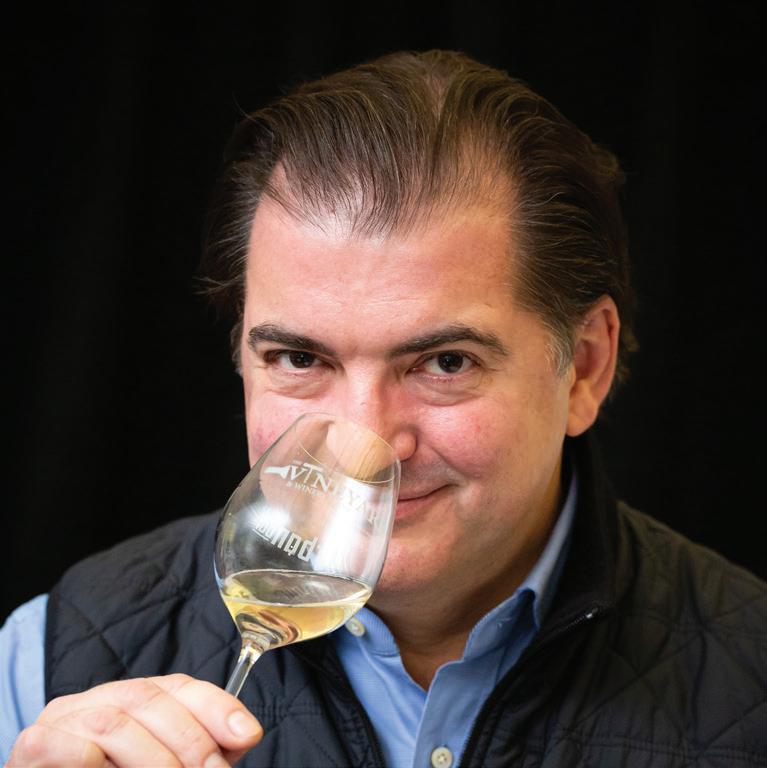




The WineGB trade and press tasting took place on 4 September 2024. This annual event was packed once again and had so much to offer the stream of visitors. 18
26






Yorkshire Heart is a family vineyard with three generations working together at this expanding business. The atmosphere created is something truly special.
Tanks for everything
Keeping liquid contained, monitored and controlled is a fundamental part of winemaking. It’s important to know your tanks so that you can select the appropriate vessel.


An investment resulted in a Dropbox link to 2,500 technical plans for a range of machinery that Rob Burr knew from experience was some of the best on the market.





“What really matters is what you do with what you have.”
H G Wells



Conversations this month have often revolved around the thought of trying new things. These thoughts have not been confined to one aspect of the industry but have literally travelled from ground to glass.



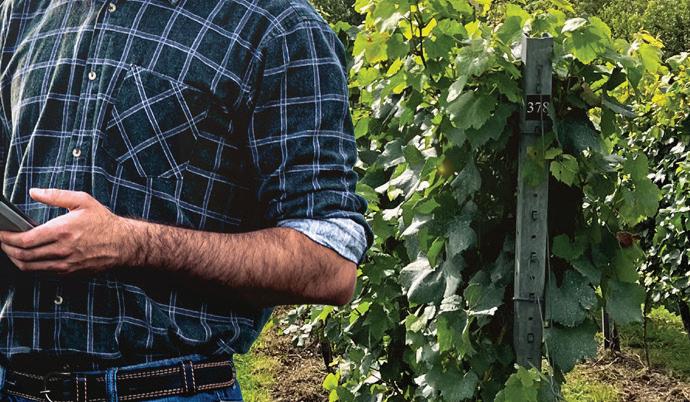

The month has seen numerous events showcasing the very best English and Welsh wines (pages 13, 18 and 22) and with these wine tastings comes the possibility of finding something thoroughly new, surprising and unique but this month on a visit to Yorkshire (page 26) there were also surprises to be found in the vineyard and winery. Planting new varieties and then using these to make new wine styles is definitely making the most of a vineyard in a cool climate.
A good debate brings together ideas and usually everyone has something they will take away so progress is something we achieve together. As part of the WineGB trade tasting a sustainability debate was held with a panel of experts this debate also invited questions from the audience. One significant point was that sustainability is not about trying to do everything and becoming overwhelmed but doing something and making it work well. Making a difference in small incremental steps is possible for all of us from large commercial businesses to the private individual.



To keep track of my stocks?
To create and manage spray plans?
As the school holidays have come to an end it is great to reflect that we have so many tourist trails and wine destination experiences within England and Wales but there is always room for improvement. Whilst the internet is one source of inspiration for tourists, it is natural for tourists to pick up ideas about places of interest from leaflets and QR codes in hotels, train stations, tourist information centres and even some strategically located restaurants. It would be good if English and Welsh vineyards were more commonly found amongst these options.
In the sci-fi thriller War of the Worlds, H G Wells depicted nature as the ultimate victor. The pandemic taught us much about the value of the outdoor experience not just in terms of enjoyment but also wellbeing. What can be more beneficial than the beauty of a flourishing vineyard combined with the ability to connect with local produce. So with reference to the quote at the top of this column, what we have is great, don’t whisper about it lets really make some noise.
In vineyards and wineries across England and Wales it is time to turn attention to the prospect of harvest and all at Vineyard magazine send our very best wishes as Harvest 2024 commences.
A personal plea from the editor... Since I have a broken foot and will be unable to get out into the vineyards of England and Wales this year to witness harvest first-hand, please bring harvest to me and send all your photographs and stories to Vineyard magazine. For my work planning and record keeping?

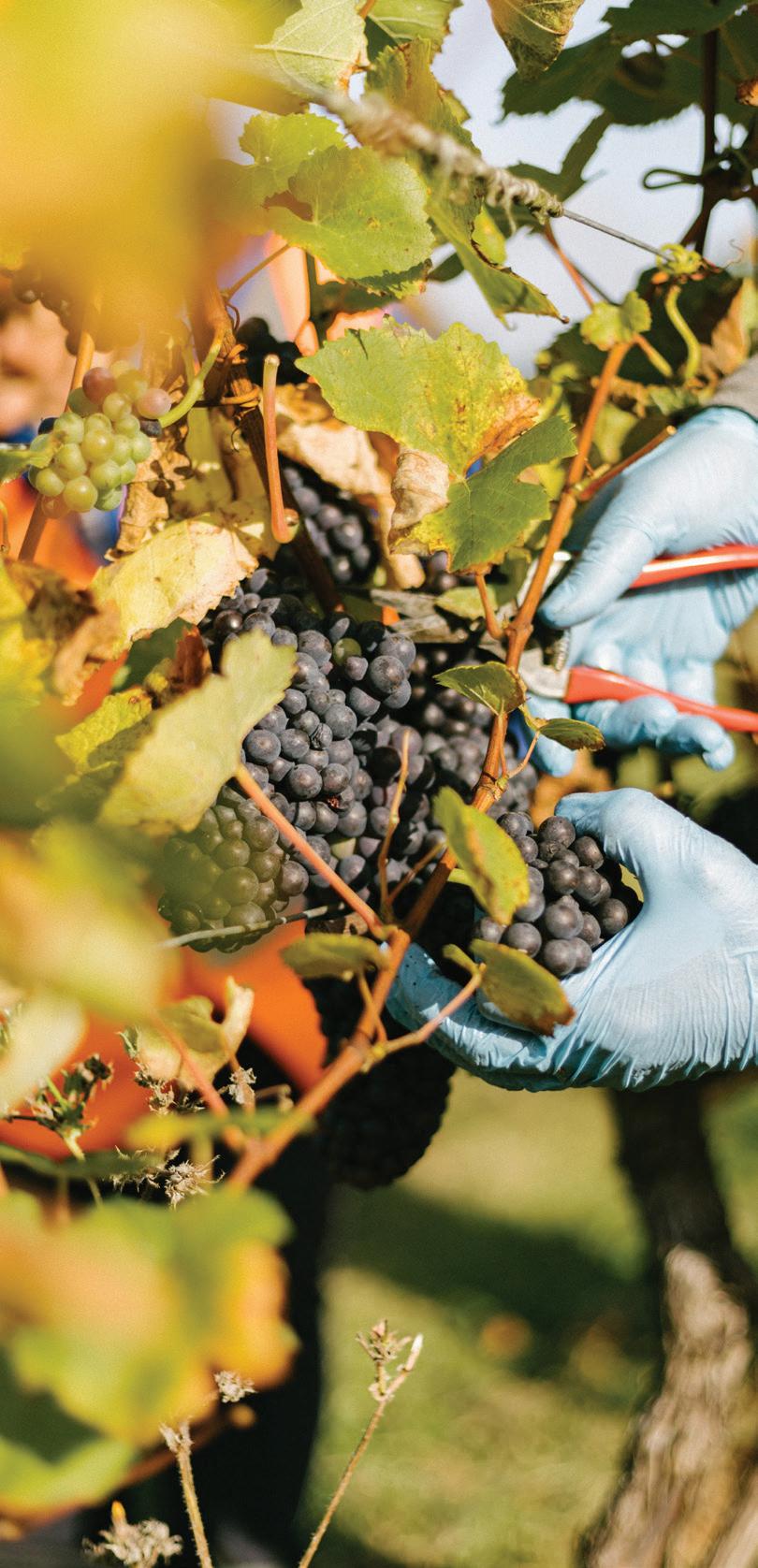








A new foundation has been launched to support and improve the mental health of those living and working in rural and agricultural communities.
The Rural Communities Mental Health Foundation is primarily dedicated to supporting people in Northamptonshire, Buckinghamshire, and Bedfordshire. However, it will extend its services to anyone approaching them from other counties.
Its unveiling coincides with World Suicide Prevention Day on September 10 and one of the foundation’s key aims is to reduce the number of people losing their lives to suicide.
The co-founders of the charity are from farming backgrounds and their families have been directly affected by suicide, so understand the impact and devastation of losing a loved one in these circumstances.
Wider research on mental health in rural areas also reveals:
◆ The suicide rate for male farm workers is three times the male national average
◆ Three people in the UK farming and agricultural industry die by suicide every week
◆ The top three barriers stopping men reaching out are the stigma around mental health (18%), not knowing who to turn to (15%) and lack of awareness of support available (15%)
The nuances of agriculture are what makes it unique and rewarding, but these nuances can also make it extremely challenging. They include time spent alone, the impact of

external socio-economic and political factors, and the unpredictability of the seasons.
It is not just those directly involved in farming that can suffer from poor mental health – no one within a rural community is immune.
Having lost their brothers to suicide ten and five years ago respectively, The Rural Communities Mental Health Foundation co-founders Kate Scott and Lewis Hunter came together and identified the need for a dedicated mental health awareness and suicide prevention charity locally.
On founding the charity, Kate said: “It’s our aim to help anyone struggling with their mental health realise they’re not alone and help and support is out there.
“We will deliver funded training to empower people to have more confident and informed conversations, focussing on free Mental
Health First Aid training sessions initially, and will work to educate the next generations and normalise the conversation around mental health and suicide.”
Lewis Hunter added: “It’s our hope that the work the charity does will stop people reaching the same crisis point as Max and Robert, instead showing them that there’s hope”.
To achieve its aims, the Foundation is engaging with everyone in the community, including farmers and farm workers, rural businesses such as machinery dealerships and veterinary practices, and Young Farmer’s Clubs.
It will facilitate collaborative working amongst local and regional organisations and charities to achieve the collective aim of better mental health and suicide prevention in rural areas.
To discover more, visit www.rcmhfoundation.org

A Guide to Vineyards and Wines of Oxfordshire and North Cotswolds by Marcus Rees published by Meze Publishing.
Tour guide and expert in all things wine, Marcus Rees invites his fellow enthusiasts to embark on a delightful journey around the winemakers of Oxfordshire and the North Cotswolds. This unique guide reveals the beauty of English wine, and Marcus would argue there are none better than those from Oxfordshire and its surrounding counties! From one of England’s oldest wine producers at Stanlake Park to newcomers like JoJo’s Vineyard, Oxfordshire Uncorked shines a light on the often unsung past
and bright future of great English wine.
Marcus fell in love with Oxfordshire after his studies at Oxford University and has travelled the length of the county and beyond to explore its many vineyards and wineries.
Oxfordshire Uncorked’s detailed profiles provide an in-depth look into each vineyard and winery’s processes and ethos, as well as tasting notes for the wines they produce. The book includes essentials like the vineyard’s first vintage, its acreage, and visitor and tour information, with each site description offering further insight into the story of the land, the wine, and the people behind its production.

The English Garden collection is available at selected Shepherd Neame pubs and hotels and its Brewery Shop in Faversham
Britain’s oldest brewer, Faversham-based Shepherd Neame, has launched its first collection of English wines, in collaboration with award-winning Balfour Winery.
The two family-owned, independent Kent businesses have come together to create English Garden, comprising an elegant white wine and crisp rosé using Kent-grown grapes.
It is the first time that Shepherd Neame – known for centuries of brewing beer - has released its own English wine, working with the team at Balfour’s Hush Heath Estate in the heart of the Weald.
The English Garden White Bacchus boasts appealing aromas of rose petal and elderflower, along with vibrant citrus flavours and hints of apple.
A dusky pink in colour, the English Garden Rosé offers aromas of ripe summer strawberries, raspberries and rose petal. It has a crisp flavour with a finish of lush wild nectarine and hint of thyme.
Michael Prior, Shepherd Neame’s Wines and Spirits Manager, said: “Shepherd Neame is committed to working with local businesses and suppliers wherever possible and we are passionate about championing English wines, including offerings from our Kentish heartland. We are delighted to see this special partnership come to fruition, and look forward to our customers enjoying our beautiful and elegant English Garden wine.”
Balfour’s Head Winemaker Fergus Elias, who led the team in producing the new collection, said: “This is a really exciting time for English winemaking, particularly in Kent which is becoming known
as the Wine Garden of England with more and more vineyards being introduced in the region. We were delighted to work with Shepherd Neame on this exciting project to raise the profile of Kentish wines and are incredibly proud of the finished result.”
The wine, which is produced and bottled by Balfour Winery near Marden, is now available by the glass or bottle in selected Shepherd Neame pubs across Kent, London and the south east.
It is also available to buy from Shepherd Neame’s Brewery Shop in Court Street, Faversham.


The South of England Agricultural Society’s 2024 Farming Conference will take place on Wednesday 13 November, at the South of England Showground in Ardingly, West Sussex. It will address the question, ‘What is our land for?’
This year's event, which will take place in person and online, will be led by Charlotte Smith, presenter of BBC Radio 4’s Farming Today. It will feature an in-depth discussion with a panel of distinguished guests, focusing on the unique challenges and opportunities related to land use in the South East of England. As always, the conference will conclude with a Q&A session, providing ample time for audience interaction and debate.
Talking about this year’s subject, Duncan Rawson, a Nuffield Scholar sponsored by the Society, and chair of the conference organising committee, said: “The South East of England is a microcosm of the broader issues facing the UK. It encompasses bustling urban centres, vast agricultural lands, and areas of significant natural beauty and biodiversity.
“The land here supports a high population density, a robust economy, and crucial infrastructure. However, this also brings challenges such as housing shortages, environmental degradation, and the impacts of climate change. Moreover, the region’s agricultural land is often of marginal quality, which poses significant challenges for profitable food production when we see increasing pressure on the land and decreasing government support for agriculture. This reality compels us to consider whether the focus should shift from food production to enhancing environmental and
biodiversity outcomes. Whether we should embrace the relentless tide of commercial development or resist it at all costs. Where does the balance lie? What is our land for?”
Discussing this vital question will be a distinguished panel of leaders in their fields – Paul Christian, Managing Director of Sentry; Tom Heap, journalist and author; Tim Slaney, Interim Chief Executive Officer of the South Downs National Park Authority; and Ben Taylor, Managing Director of Iford Estate.
Paul Christian: Paul leads Sentry, an employee-owned farming and advisory business specialising in rural asset management, contract farming and management services for private and corporate landowners. Operating nationally, covering 23,000 hectares of land, producing 200,000 tonnes of produce annually and providing additional management and advisory services across 40,000 hectares for clients and associates. Paul is a passionate advocate for local food production.
Tom Heap: Tom is a regular presenter on BBC1’s Countryfile, specialising in the more investigative films, and has made many BBC Panorama documentaries on food, energy and the environment. Tom is also the presenter of Radio 4's new Rare Earth series and was the anchor of The Climate Show on Sky News. He was the creator and presenter
of BBC Radio's flagship climate change podcast, '39 Ways to Save the Planet'. His latest book is ‘Land Smart: How to Give People and Nature the Space to Thrive’.
Tim Slaney: Tim oversees the vision and strategy for the South Downs National Park Authority, focusing on nature recovery, climate action, and being a ‘National Park for All’. He is passionate about Britain’s newest National Park being accessible to everyone and promoting the multiple benefits the area offers to residents and visitors alike.
Ben Taylor: Ben manages a 1,200-hectare mixed farming business within the South Downs National Park. The estate has launched a progressive biodiversity project to restore habitats and create spaces for nature while retaining food production on its most fertile land. This project aims to generate new income streams through the sale of Biodiversity Net Gain credits to developers and other companies looking to offset their environmental impact.
The Farming Conference will run from 7.30pm to 9.30pm on Wednesday 13 November 2024 (6.30pm to 10.30pm if attending in person, including pre-event and post-event refreshments and networking opportunities). The conference is free to attend, in person or online, but visitors must register at www.seas.org.uk/farming-conference
Kicking off the

Our newest student cohorts have just started, with the winemakers, vineyard managers, and wine business leaders of the future stepping through our doors for the first time.
This year we have plenty in store for new and returning students. We’ll kick off the Semester with our Harvest Party, for all the students and staff. This popular event has been growing each year, and Dr Akshay Baboo is quite the master BBQer.
Anyone who has been a student or attended a course will know learning isn’t just about acquiring knowledge. It’s about the social aspect, the links to industry, the community engagement, and the extras. We love putting together a programme of guest speakers, trips, and enrichment for the students, and they have quite the array this upcoming academic year.
Our free weekly French lessons will be continuing, to help students learn a new skill –a very valuable one in our industry – as well as socialising. Wine Production student Campbell spoke to us at the end of last semester: “When I started the year, I barely spoke three words in French. Now I’m planning a Spring trip to the Loire! Liz is an excellent tutor and we always
have fun”. Students will be using their French for college trips (watch this space) as well as for their personal and professional futures.
One student keen to spend time working in France is Moses, who used the French lessons as an opportunity to write a presentation on the Jura, bring in a bottle (we supplied the cheese) and tell us all about it. We know these sessions build confidence and friendships as well as skills.
Thinking about advancing your career and personal development? Visit
www.plumpton.ac.uk/wine to explore our range of CPD specialised short courses, WSET courses, degree courses, and more in wine production, viticulture, oenology, and wine business. Courses include essential new skills, from lab analysis to digital communication. As the harvest season comes to a close, it’s the perfect time to reflect and plan for the year ahead.
Sarah Midgley, Programme Manager Viticulture Apprenticeships
Sarah has been working at Plumpton College since 2014, originally as the college Winemaker and Winery Instructor, in 2023 she took over as programme manager for
Viticulture Apprenticeships. She enjoys coaching and supporting our apprentices who are working in vineyards all over the country and attend college on block release for teaching. The most satisfying part of the job is getting to form and strengthen relationships with industry and going out and about to visit vineyards all over the UK. Head over to www.plumpton.ac.uk/apprenticeships to learn more about our Vineyard Crop Technician Apprenticeship programme.

Sarah Midgley
As Squerryes continues to win awards for its sparkling wines, including a Silver and Gold in this year’s International Wine Challenge Awards and 93 points for two of their wines in the Decanter awards in 2024, the family-owned vineyard in Westerham goes from strength to strength. Exciting expansion plans include the appointment of experienced and passionate Winemaker Tom Jones.
Born in New Zealand, Tom has gained 13 years of experience in the wine industry providing expertise at vineyards around the world. He will be taking up his new role at Squerryes having previously been Winemaker at the Gusbourne Wine Estate.
Tom said: “From the first time I visited, I could tell Squerryes was a business filled with positive, valued, ambitious people and I couldn't help but want to be a part of its journey. My aim is to ensure Squerryes consistently produce wines that best reflect its terroir, and to ensure the vineyard can continue to develop its wines going forward. Not to step away from the successes achieved in the past, but to simply build on them for the future.”
As part of the vineyard’s expansion, a winery has also been built on the Estate

this year and will be open in time for this year’s grape harvest. The 2024 vintage is expected to be the first released from the winery in 2028. On the main visitor site, a new Tasting Bar has also been created to provide additional space for visitors to enjoy Squerryes’ wine and small plates.
Henry Warde said: “We are looking forward to producing our first vintage in the new winery and also working with Tom as our business grows. We produce around 75,00085,000 bottles of sparkling wine each year and we expect this to increase with the new winery which will help meet the ever-growing demand. As the vineyard enters a new exciting chapter in its expansion, this is the first time wine production has taken place on the Estate and marks a significant milestone for us.”
The new Tasting Bar is located downstairs from the restaurant, with countryside views across the summer terrace to the Rosé vineyard. Visitors are invited to spend a few hours throughout the day or evening enjoying Squerryes, with small plates from the two AA Rosette award-winning kitchen. Diners in the restaurant are welcome to book for an aperitif. The bar opened on Friday 20 September.

Highly acclaimed Langham Wine Estate has launched its new release of Blanc de Blancs NV, produced entirely from Chardonnay grown on the chalk soils of its rural Dorset vineyard. Priced at £43.95.
Compared to Langham’s Corallian, its Chardonnay-dominant blend, the base wines for the Blanc de Blancs come from a higher proportion of oak, and the wine spends longer on the lees during secondary fermentation.
Head Winemaker of Langham Wine Estate, Tommy Grimshaw said: “The Blanc de Blancs is always the wine with the broadest shoulders in our range. This wine showcases our oxidative approach and desire to produce complex, layered sparkling wines. To achieve this we select specific parcels of the best Chardonnay from the previous vintage and blend it with a small amount of reserve wine to elevate the palate. This wine is something that we are always proud to release.”
Langham’s Blanc de Blancs NV is produced
from 90% 2020 vintage and 10% reserve wines. The fruit is pressed oxidatively in a three tonne pneumatic press then the juice is left to settle overnight – the first of many characteristic steps in the winery’s low-intervention method.
The juice is then racked into a combination of stainless steel and old, predominantly French oak (minimum three years old, ex Champagne, Burgundy, Bordeaux). Alcoholic fermentation occurs spontaneously, followed by full malolactic fermentation and prolonged ageing with regular bâtonnage. As with all Langham’s wines, the new release of Blanc de Blancs is unfined and unfiltered, and is suitable for vegetarians and vegans.
Less sugar is added at tirage, leading to a lower bottle pressure of around 4.5 bar. The winery’s approach prioritises blending from an array of complex base wines which are complemented, not dominated by autolysis from around three years of lees ageing in the bottle after second fermentation.
Following a successful inaugural event in 2022, Tim Wildman MW hosted a second BRÍT-NAT tasting on 3 September at Soif restaurant in Battersea, showcasing over 50 wines from over 30 English and Welsh producers, each made in the pétillant natural, dubbed pét-nat style, writes Sophie McLean.
In only two years, this more creative style of winemaking is showing steady growth based on the total producers Tim estimates are now in existence. In 2022, 25 producers were making a wine in this style, a number Tim now considers to be 45, representing “an 80% increase”.
“I think this tasting is a good thing, there aren’t too many like it” said Alex Hurley, winemaker at LDN CRU whose Pinot Gris Sparkling Rosé 2022 was one of the wines on show. “It’s the creative wine of the vintage," he added. "We make culinary-focused still and sparkling wines but this one tends to be a reflection of me – a ‘what happens if I do this?’ kind of wine.”
Backing up this statement Tim Wildman said: “None of the wines on show are primarily ‘terroir’ driven, instead they reflect the personalities of the winemakers and their individual approaches to winemaking.” According to Tim you can think of wine as being divided into two categories, fine wine and fun wine, and pét-nat definitely sits in the latter.
Across the fifty wines on show, this bottled fun is best viewed through an aromatic and chromatic lens; banana, cotton candy, rose hips and cheese rind are just some of the
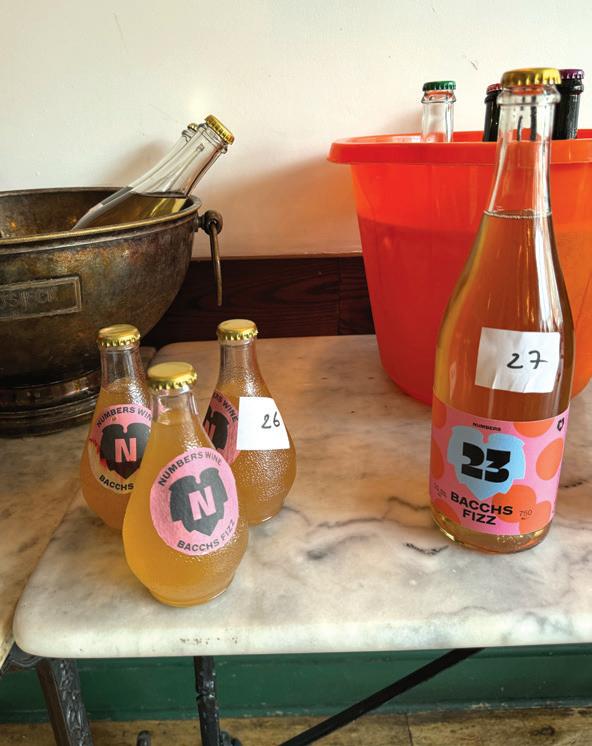

repeated tasting notes. There are more pinks and reds on show than whites, colours that pop alongside the labels, all similarly playful in nature.
Grapes range from more recognisable coolclimate friends to the more unique ‘Triomphe’, ‘Phoenix’, ‘Regent’ and ‘Orion’ – the latter used by Ark Wines, the grapes are from Mount Farm Vineyards in East Anglia, whose profits are donated to Eden-Rose Coppice Trust in honour of the vineyard owner. Tim Wildman MW makes pét-nat in England under the Lost in a Field label where the motto is ‘Drink the Rainbow!’
BRÍT-NAT featured 50 wines many carrying joyful names such as Here Be Dragons Forbidden Fruit, Frolic, Good Day and the top contender for most creative named wine, Last Night a DJ Seyval’d My Life which is a méthode ancestrale, from producer Quatro Mustachios in West Sussex.
Outside of the creativity, the other benefit of these wines from a production side is that they are quicker to make. “You can harvest in September and be in the market on sale in April the following year,” said Alex. An attractive proposition when it comes to cash


flow. There is not a long waiting period for these wines to age on their lees or in barrel, or a need to use cages or expensive foil casing; most pét-nat are bottled under crown cap, drawing quicker ROIs when compared to their traditional method counterparts.
Easily the most surprising wine on show of the day was not the funkiest in the room, but the most commercial- a pét-nat rosé commissioned for Marks & Spencer, by buyer Dror Nativ MW, first released in April and priced at the lower end of many others on show at £15.99 a bottle. Much ‘cleaner’ than many of its peers, it is made with more traditional varieties (pinot, chardonnay dominant) using the pét-nat intermission method allowing it to be undisgorged leaving yeast sediment to add creaminess – something a little safer in style than some others, but equally daring in category for such a mainstream outlet. It should also be noted that Gen Z are reportedly returning to the high street retailer for fashion. A style renaissance all round, and looking at the pét-nat drinking demographic, could mean, whoever is most daring, wins or at least has some fun by trying.

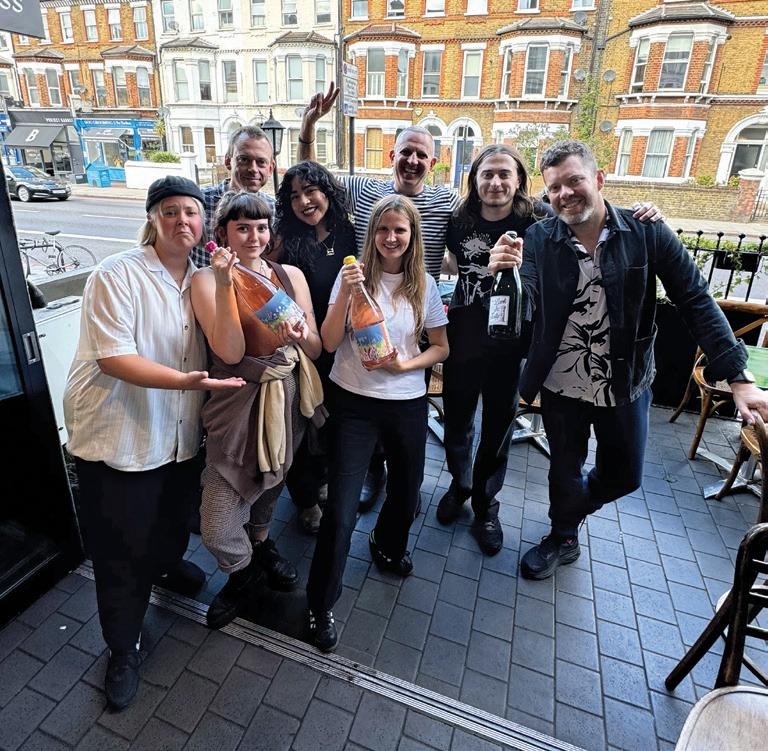


Wildlife charity Butterfly Conservation has today declared a national ‘Butterfly Emergency’, with results of this summer’s Big Butterfly Count showing a marked and hugely concerning decline in numbers.
Overall, participants spotted just seven butterflies on average per 15-minute Count, a reduction of almost 50% on last year’s average of 12, and the lowest in the 14-year history of the Big Butterfly Count.
It was the worst summer in the Count’s history for Common Blue, Holly Blue, Green-veined White, Small White, Small Tortoiseshell, Painted Lady and Scotch Argus. And the majority of species (81%) showed declines in the number seen this year compared with 2023.
In total, just over 935,000 butterflies and day-flying moths were recorded across the UK from 12 July - 4 August, down almost 600,000, equivalent to more than a third of 2023's total, and 9,000 Counts were logged as seeing zero butterflies, the highest in the citizen science programme’s history.
These figures have alarmed scientists and resulted in the charity declaring a nationwide ‘Butterfly Emergency’.
Dr Richard Fox, Head of Science at Butterfly Conservation, said: “The previous lowest average number of butterflies per Count was nine in 2022, this latest figure is 22% lower than that, which is very disturbing. Not just that, but a third of the species recorded in the Big Butterfly Count have had their worst year on record, and no species had their best. The results are in line with wider evidence that the summer of 2024 has been very poor for butterflies.
“Butterflies are a key indicator species; when they are in trouble we know



that the wider environment is in trouble too. Nature is sounding the alarm call. We must act now if we are to turn the tide on these rapid declines and protect species for future generations.”
To find out more about Butterfly Conservation visit: www.butterfly-conservation.org
What if your next glass of wine could change a life? The Fifth Trust, a Kent-based charity, is thrilled to unveil two new wines from its Elham Valley Vineyard with all proceeds going directly towards supporting adults with learning disabilities.
The fresh additions – a sparkling rosé from the 2022 Seyval grapes and a still rosé from the 2023 Seyval and Pinot Noir harvest – are the latest in a line of exceptional wines that not only taste good but do good.
The Fifth Trust provides essential day care services for around 170 adults with learning disabilities across two sites in the Elham Valley, Kent. Through community work, creative activities, and practical life skills, the charity helps its students build confidence and independence. The vineyard is a key part of this mission where students actively participate in the winemaking process, from vine maintenance to bottle design.
Social enterprise manager Peter Stratton said: “Our vineyard is more than just a
beautiful setting. It’s a place where our students learn, grow, and contribute in meaningful ways. By enjoying our wine, you’re supporting the invaluable services that help our students live fuller, more independent lives.”
Elham Valley Vineyard wines are available at The Fifth Trust’s vineyard garden centre and café, as well as online at www.vineyardgardencentre.co.uk/shop. Proceeds from all sales are reinvested into the charity, funding essential programmes that enrich the lives of adults with learning disabilities.
With your support, The Fifth Trust can continue making a difference. Discover the new wines and be part of something truly special.
For more information about The Fifth Trust, visit: www.fifthtrust.co.uk. You can visit the vineyard seven days a week between 10am4pm at Elham Valley Vineyard, Barham, Canterbury, Kent, CT4 6LN.
An increasing trend in the UK wine world has been the planting of vineyards in East Anglia with its lower rainfall and higher temperatures being very suitable for grapes writes Richard Shepherd-Barron.
The contract winemaker, Defined Wines, based near Canterbury, opened their new winery near Dedham in Suffolk in early September. This facility will be available for the rapidly expanding vineyards in East Anglia – notably Essex, Suffolk and Norfolk – and this will also help their existing customers in these areas, who no longer have to transport their grapes to Canterbury for production with the possibility of long traffic delays at the Dartford Crossing.
The initial permanent staff of five all live locally and the modern premises has a current capacity of 100,000 litres. A major part of Defined Wines success has been the investment in modern winemaking equipment. As CEO Henry Sugden commented in May this year: “When making winemaking decisions, it is vital to have accurate results fast and in time to make decisions regarding bottling, etc. So, we have a fast turnround. There is no point getting results back after the wines have gone to bottle.” Thus, there is also a laboratory at Dedham as part of the impressive new equipment installed there.
The opening of the new plant was attended by some 60 people –growers, local farmers thinking about viticulture, wine buyers, local councillors and also the local MP, James Cartlidge, who spoke very positively about the growth of local agricultural businesses in his constituency of South Suffolk and how vine growing and winemaking
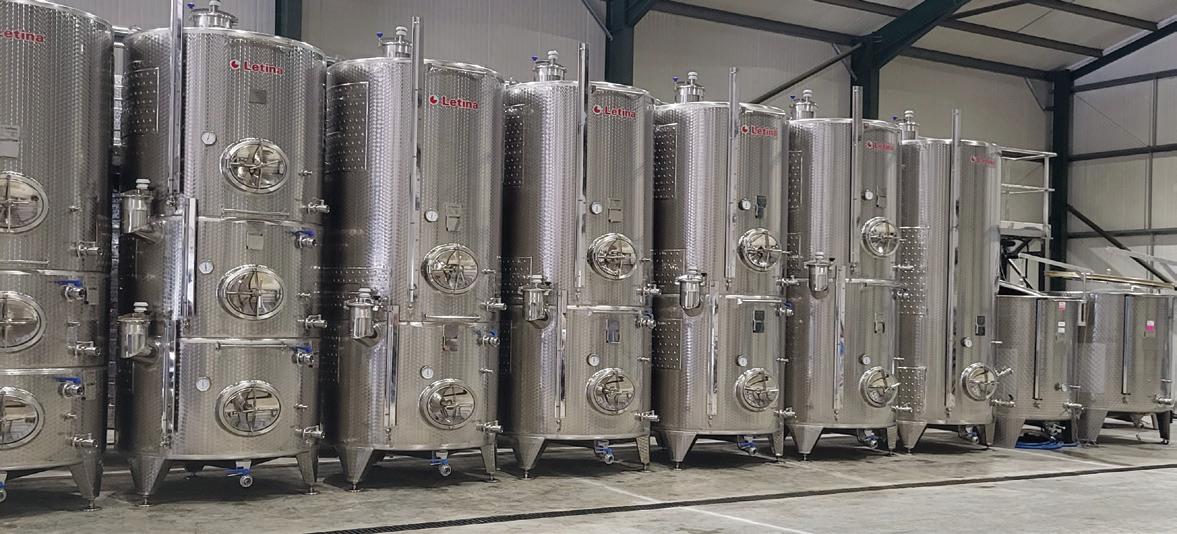
was a creator of employment in rural areas.
Henry Sugden commented about his business which has grown enormously from its start in 2018: “Our approach has been to use taste, experience and modern technology to ensure that we can continually produce the best quality wines. A good wine starts in the vineyard so we also provide viticultural support for the growers we work with, helping them to improve their knowledge and the quality of their grapes.”
Henry is very optimistic about the future of English wines as more consumers start to realise the quality of wine that is now being made on their doorsteps. He said: “The key challenges I see for growers are ripeness and yields as well as for brands, differentiating themselves from others in an increasingly crowded market. There’s a lot of room for growth to increase market share.”

The ever-popular Matthew Jukes masterclass, always one of the highlights of the Vineyard & Winery Show, returns for a fourth year with another great selection of wines from the Vineyard columnist and world-renowned expert.
Matthew’s masterclass is a favourite with the whole range of show visitors, from the knowledgeable to the newbies. Matthew’s engaging style allied with years of experience in assessing great wines makes his masterclass an unmissable event, scheduled to take place this year at 1pm in the Tasting Marquee.
With many of last year’s selections having gone on to be award winners and best sellers, Matthew's choices are not only impressive but show his amazing insight into what makes a great wine. As many will agree, the way he describes each wine makes you want to buy six on the spot. Vineyard Magazine is pleased to announce Matthew’s selection:
◆ Biddenden Vineyards 2023 Gewurztraminer
◆ Vagabond Wines
Solena Batch 003
◆ Camel Valley
2022 Pinot Noir
◆ Greyfriars / Goldenford
2022 Chardonnay
◆ Warehorne Vineyard 2023 Oasthouse Divico
◆ Great Wheatley Vineyard
2023 House on the Hill Bacchus
All proceeds go to The Drinks Trust. Tickets cost £25 and can be ordered by going to www.vineyardshow.com as this event is extremely popular please book early. Masterclass sponsored in 2024 by
The work Gullands undertakes for wine producers and the wider viticulture sector is led by the Commercial and Corporate team headed by Partner Catherine Lloyd and the Under Sherriff of Kent. This team has grown in recent months and offers comprehensive and expert legal advice to business owners, commercial property owners and landowners. Gullands have extensive experience and a real understanding of the rural community in Kent and Medway and at the show will welcome the opportunity to discuss all agricultural and land related issues with farmers, fruit growers and vineyard owners. In what for some are challenging times, they can support in discussions regarding the diversification of your business, new income streams such as Biodiversity Net Gain (BNG), Solar Farm Agreements, residential and other developments.
Gullands also advise on business structure and succession and contentious matters including disputes, Health & Safety and
WineGB, in partnership with the Vineyard & Winery Show are launching a new award for UK Producers at this year’s event.
Entitled the ‘Golden 50’ WineGB’s top 50 choices will be taken from the 123 UK wines that have won Gold medals across seven UK and international competitions during 2024, including: Wine GB Awards, Welsh Wine Awards, Decanter World Wine Awards, IWC
Wine Awards, IWSC, and The Champagne & Sparkling Wine World Championships.
Ensuring that the best of the best is fully appreciated and receive the acclaim that they deserve, the Golden 50 will have a WineHub dedicated to them where all the wines will be available to taste during the day.
Full details on which wines have made it through to The Golden 50 will be announced in November edition of Vineyard magazine.

regulatory matters, employment and licensing. Gullands can assist with the negotiation and preparation of all types of commercial contracts and in the acquisition and disposal of businesses and companies in the sector. Together with the Employment team, they can negotiate terms, manage the due diligence process through their data room system, draft appropriate documentation and advise throughout the process. www.gullands.com














Promote your Piwi wine at this year’s Vineyard & Winery Show 20 November 2024











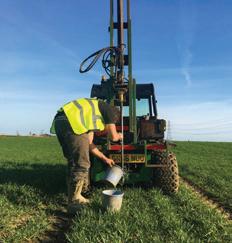






















































For the first time at The Vineyard & Winery Show we will have a Wine Hub dedicated to UK wines produced from Piwi varieties. Following on from last year’s success of 100 guests taking part in a structured Piwi wine tasting, we felt that the time was right to allocate a whole section to Piwi varieties at this year’s event, taking place on 20 November at the Kent Showground.





















Visitors will be invited to sample varietal wines and blends from a host of varieties such as Solaris, Divico, Caberet Noir, Orion, Phoenix, Seyval Blanc and many more. This is a fantastic opportunity for growers and winemakers to place these new wines in front of a large audience including press and industry professionals. Each wine will be listed in Vineyard magazine’s preview of the show in November (published in print and online), plus each wine will be promoted in the Show Guide which is handed out to each visitor on the day. For producers of Piwi wines this really is an opportunity not to be missed. To take part and for further details, please email jamie@vineyardmagazine.co.uk


The WineGB trade and press tasting took place on 4 September 2024. This annual event was packed once again and had so much to offer the stream of visitors.
The largest ever WineGB trade tasting produced something for everyone but as the number of exhibitors grows each year it also presents a challenge. Watching the experienced sommeliers, buyers and wine writers circling the room it is clear that no one wants to miss the experience of something extraordinary. So many vineyards and wineries were able to showcase the best, the novel and the new wines they have produced that those who are here to discover English and Welsh wines are under pressure from the start to the finish of the day.
Lauren Baldock and Charlotte Bailey of Silverhand Estate highlighted the latest release a Charmat method Rosé that is 100% Pinot Noir. “It has been released for just over two months and has proved really popular with consumers over the summer,” said Lauren. Silverhand Estate has about 700 acres under vine and a cellar door that can encourage consumers to enjoy English wine through tours and tastings. With this new exciting charmat method rosé that has a price point of £18 many more consumers will be encouraged to start their English wine journey. With a one million bottle capacity Silverhand have no intention of standing still and there are plenty of expansion plans at Silverhand.
Another vineyard with exciting plans for the future is Velfry Vineyard based in the picturesque Pembrokeshire Countryside. Andy Mounsey, owner of Velfrey Vineyard once again returned to London with a mixture of still and sparkling Welsh wines. “The event has been beneficial over the years. We have been able to identify some trade customers who have come back to us but more than that we have the opportunity to raise awareness of the vineyard and the wines and more generally the vineyards throughout Wales. Even at this event people are surprised to learn that there are over 50 vineyards in Wales,” Andy said.
One of the still wines that visitors were able to try was the Velfrey Solaris 2023 “We currently make 1,000 bottles of this and it is sold out within a few months,” said Andy. This is not surprising as Welsh wines using Solaris grapes are winning awards and developing an expanding customer base. There is hope for those who enjoy these wines however as Andy explained that Velfrey have expansion plans with an area already under preparation to plant more Solaris vines next year.”

Another vineyard from Wales that has been part of the WineGB event for many years is Montgomery Vineyard, situated in Powys mid Wales. Montgomery have a variety of unusual still wines such as Seyval Blanc. “Pinot Noir Précoce is challenging to grow but we have so far done well with this, we also have Solaris as a still white which is probably one of our best sellers we have to allocate bottles to our customer base. Our wines are sold in just over 200 independent wine merchants,” said owner Woody Lennard. “We have had great feedback today and this is a great event. We have been attending for several years and it is great to see old friends and meet new people,” he concluded.
The team at All Angels will be celebrating their tenth anniversary in 2024 and founder Mark Darley spoke about the benefits of taking part in the event. "The Wine GB tasting was very helpful for us. This is a very important time for English and Welsh wine, and with significant growth in the market it’s essential for us to build and nurture trade relationships now more than ever. Tastings like this are an invaluable opportunity to do this in an effective and efficient manner across a single day, especially for a producer looking to expand distribution in the independent trade as we are currently.
A limited edition 2014 Classic Cuvée will be released to mark the tenth anniversary and Mark explained: “At All Angels, our style is to never rush our traditionally made wines. We always release wines once they’ve been aged for a long period of time, a minimum of six years for our classic cuvées. We believe heaven can wait. There are nine centuries of defining English history in and around our vineyards and if we are going to achieve our aim of adding to that, we need to take our time, be patient and produce our wines alongside a lasting, sustainable and improving ecosystem."
A new Pinot Gris from Henners was available to try and Tom Whitely of Henners explained: “One of the partners that we work quite closely with has planted Pinot Gris and Sauvignon Blanc as well, which is a bit unusual. We took that into the winery for the first time last year. The result is a fresh fruity Pinot Gris that we are really happy with. The label has been designed in conjunction with a wholesaler who wanted a fun label to fit in with their independent wine bar and independent retailer customer base.” Henners have not just had success with their still wines the sparkling wines have picked up international attention especially the 2018 Blanc de Blanc. Exporting to nine states of the USA and even playing a part in the recent royal visit to Kenya there are plenty of exciting things happening at Henners.
Johann Fourie, Head Winemaker at Leonardslee Family Vineyard, Sussex was at the event with the estate produced wines that were first launched in June 2024. The 38 acres of vineyards were planted in 2017 “our philosophy to winemaking is to express the site of the specific vineyard, we want to express the sense of place and showcase that in the glass. Seven years later we are excited to share these wines,” said Johann. Leonardslee are focussed on Sparkling Wines and the first releases include a 2021 Rosé which contains Chardonnay, Pinot Noir, Pinot Meunier and the Pinotage grape “after looking at the challenges of growing grapes in the UK with frost and disease pressure the Pinotage grape came to mind as a possible solution, and it lends itself to the rosé style bringing strawberry and raspberry flavours,” Johann added.




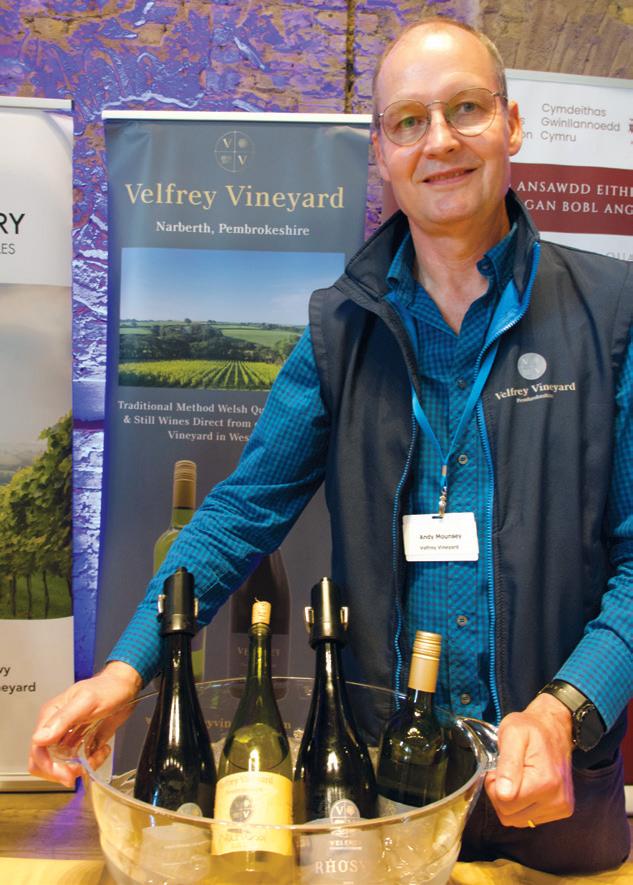

The WineGB Trade and Press tasting included a discussion based around sustainability in viticulture and how to expand the conversation regarding how to create value from the commitment to sustainability.
The panel of Ruth Simpson, Simpson Wine Estate; Patrick Schmitt MW, Editor of Drinks Business; Sue Daniel, M&S Winemaker and Senior Technologist; and Luke Harbour, Group Beverage Director of the Pig Hotels was designed to engage with the audience providing insight from the on-trade, the off-trade and producers. Hosting the discussion Anne Jones the sustainability ambassador for WineGB said: “Sustainability particularly in viticulture has to be collaborative and that is one of the brilliant things about English and Welsh wines; just how people are working together sharing successes and failure explaining what does and what does not work.”
Representing producers Ruth Simpson of Simpsons Wine Estate was asked how the business’s commitment to sustainability was justified. “I think it all comes down to the value judgements that we make. I have been raised to believe that we are stewards of the land and as a grower/producer we have that as a basis for all we do. There are some extra costs for example if we use sustainable fertiliser in the vineyard that does cost a little but more but in a lot of cases some of the choices we have made at Simpsons have actually saved money further down the
line for example two years ago we achieved our goal of installing a solar array on one of our wine storage buildings which was a significant investment but we are now able to generate 34% of our electricity needs across our business. We are also able to generate some income at certain times by exporting some to the grid. That is a tangible example that we can show visitors to our estates because consumers now are a lot more knowledgeable with a lot more interest and a lot more expectation of the product that they are going to buy.”
On the expectation from consumers Patrick Schmitt commented: “The idea and the move towards sustainability has been the biggest shift and the most important that I have seen in my 20 year career but the term sustainability is a bit vague and is really hard to define. I think the term organic is well understood by the consumer. In terms of the wine market globally the sale of wine is not in growth but the sale of organic wine is in growth. We are doing analysis of the fine wine market and collectors at the top end expect a wine to be made in an organic or biodynamic and certainly as clean as possible in terms of the eco credentials not so much because of an interest in an eco product but because they expect it to be artisanal and hands on and this tends to overlap with organics and regenerative viticulture.”
An audience comment pointed out that in a marginal climate growing organically may not actually be the best choice in terms of
sustainability for example the use of diesel and tractor time would not be considered as part of an organic system and sprays such as copper can be used in an organic system in an untargeted way but that is not in line with sustainable principles.
Since the concept of sustainability is complicated Sue Daniel commented: “As a retailer we introduced Plan A (a commitment to combat climate change, encourage ethical trading practices and reduce waste) in 2007 because we felt that it was the right thing to do and customers trust us to do the right thing and so that is where we start from. We are not just about wine and we have some big challenges in areas such as clothing and homewear there is a much bigger carbon footprint for some of those materials. We have done a big marketing campaign to help people understand what sustainability means. In a recent survey 64% are actively leading a life that they believe will be more sustainable so we know that resonates with our customers. We are asking all our suppliers to have a sustainable programme and we are actively involved in the sustainable wine round table to reduce our bottle weights.
Anne Jones pointed out to the audience that materiality is a part of sustainability which looks at what is most relevant and what is most important and within wine from an emissions perspective the answer is the glass in the bottles and from a mitigation perspective it is soil organic carbon.
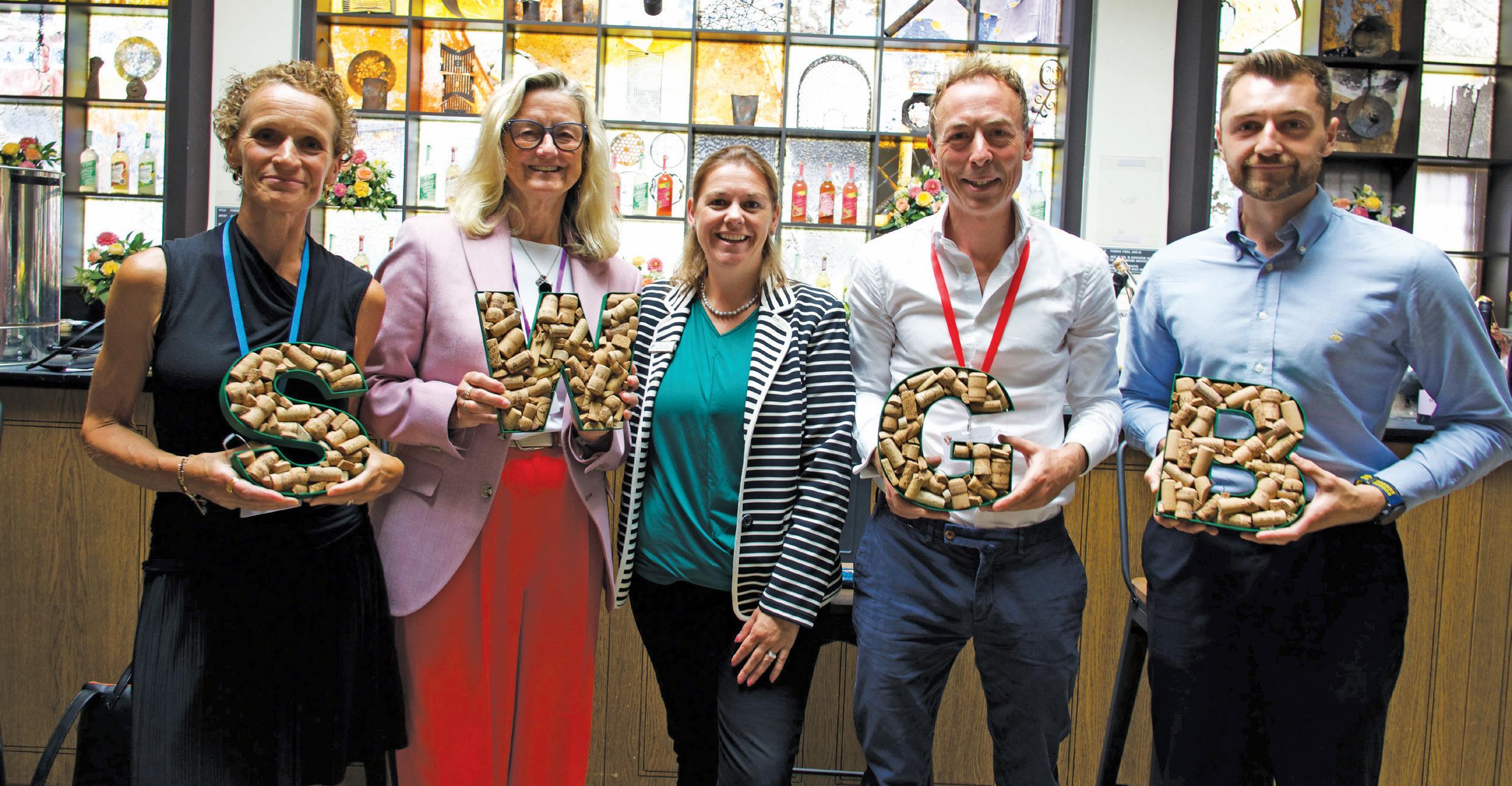
A question from the floor addressed the balance between a business need and a consumer want. The example given was that of a restaurant that is having to deal directly with producers and then receiving deliveries from multiple locations which then increases the carbon footprint of the restaurant business. Luke Harbour, Group Beverage Director of the Pig Hotels Group said: “There needs to be value at all elements of the wine list and it is important that the wines on the list do have sustainability credentials that are appropriate for that wine region or that wine style. You can strike a balance between your wine list being sustainable and having diversity of styles. At Pig Hotels our sourcing policy with food is local where we can we have a kitchen garden at every property and what we can’t grow ourselves we source from with 25 miles of the hotel beyond that we look at accreditation such as B Corp and Fair Trade but when it comes to wine the ownership is on us to embody sustainability into those wine lists. Every bottle of wine that goes onto our list goes through a rigorous selection process and our customers expect us to do this. There is a conscious consumer that is coming to us and it is our responsibility to make sure that (sustainability) is in the bedrooms, the food and the wine list.”
Sue Daniel highlighted how overwhelming the idea of sustainability can be when taken as a whole but taking little steps is the way to make sure it starts. It was clear that there are a number of programmes that are offering advice such as The Porto Protocol, Regenerative Farming and the International Wineries for Climate Action (IWCA).
The costs of being part of an accredited scheme can vary greatly and as sustainability gains greater traction there are more schemes available so it is worth noting that not all certification schemes are the same and there is research being undertaken looking at what is available through different schemes and what the costs and benefits of certain schemes will be.
As viticulture in England and Wales moves forward, free from historic rules, there is much positive work being done by many within the industry to encourage thoughts and processes that will start and continue the regenerative, sustainable journey. Although there is no solution yet there is a positive impetus to find a measurable way to indicate sustainability and regenerative viticulture as something tangible that the end consumer can assign a true value to.

The WineGB trade tasting was able to showcase the growing number and variety of still wines that are being produced in England and Wales. Ben Walgate of Walgate wines said: “We should be confident in what we can achieve with still wines. With the right vineyards and the right management now is the right time to make still wines.” Based in Rye, East Sussex the winery and wines are very much a labour of love for Ben Walgate.
Hidden Spring had a mixture of still and sparkling wines including the Blanc de Blanc 2018, Classic Cuvée 2019 and Blanc de Noir 2019. There were four still wines which included a novel (wood aged) Bacchus Fume and a wine Richard Aspen owner of Hidden Spring jokingly described as: “An easy drinking breakfast favourite Pinot Gris.”
Richard Aspen is serious about the wines produced at Hidden Spring and the next few releases from hidden Spring promise to be truly exciting. “We are a small vineyard with the luxury of our own winery,” he explained.
The WineGB trade tasting offers a great opportunity not just to talk about the wines that are current but the wines that will be released in the near future. Richard declared: “We have a small batch of Caberet Noir that will be released in the coming months it has been in oak for over two years. Originally the intention was to use the Caberet Noir as a rosè but I am from south Africa and am passionate about good red wine. When we first planted the variety, being brutally honest, we were not sure what we were going to get but I think the wine is really beautiful and we are really excited.”
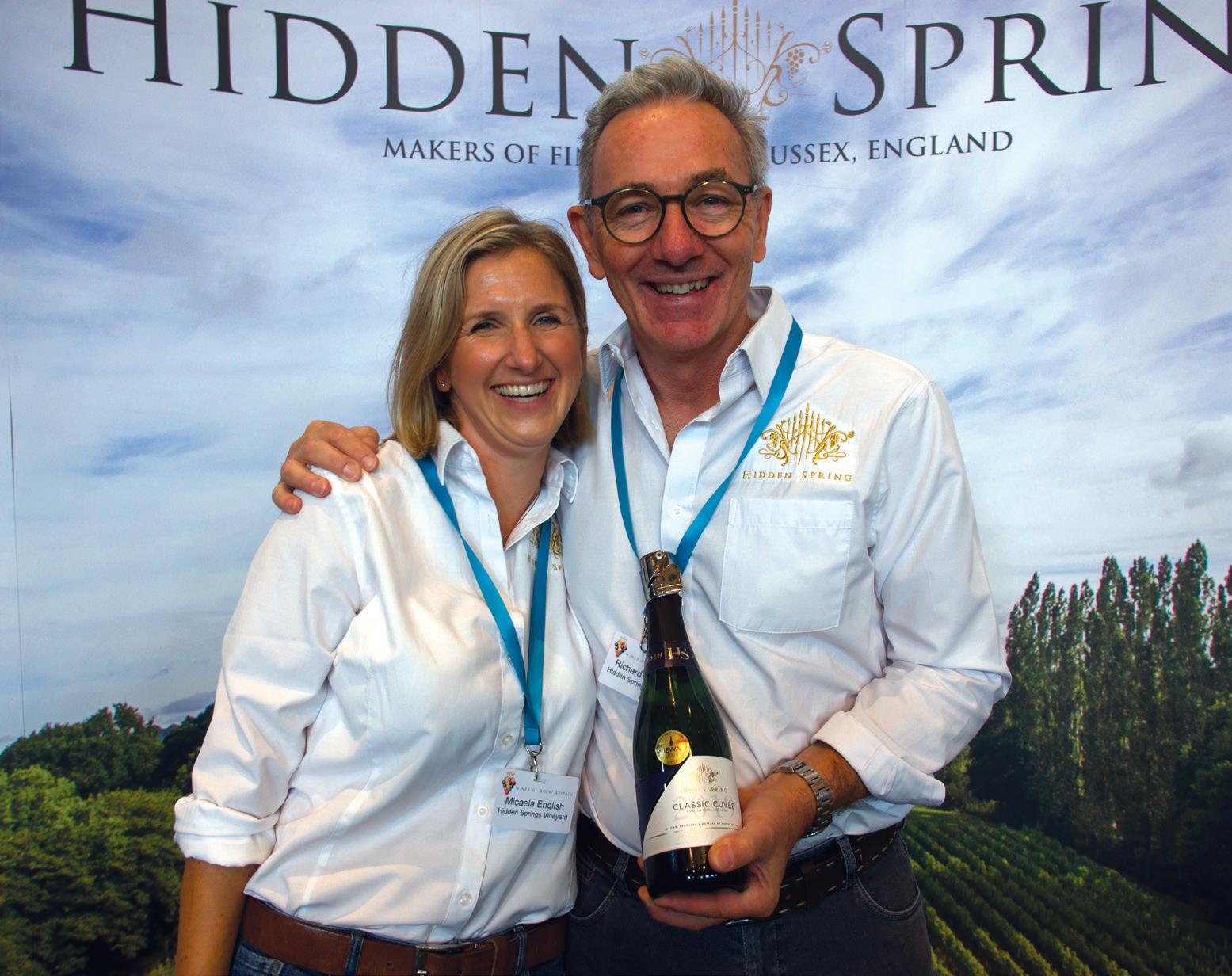
An exclusive winemaker tasting event in London, celebrating over 10 years of exceptional winemaking from Kit’s Coty, one of England’s finest vineyards. Hosted by Kit's Coty’s Head Winemaker, Josh Donaghay-Spire, the event brought together a select group of wine journalists, sommeliers, and restaurant managers from some of the UK’s most prestigious hotels, restaurants, and bars. Held at the elegant Pan Pacific London, the event was a true celebration of English winemaking at its finest.
The highlight of the afternoon was a unique vertical tasting of Kit’s Coty Blanc de Blancs, where we had the rare opportunity to sample vintages spanning several years. Starting with the first-ever vintage from 2014 and working our way through to the 2019 and 2017 vintages, we were guided through the ageing potential and evolution of this remarkable wine. Each vintage told its own story, revealing the careful craftsmanship and dedication that has come to define Kit’s Coty over the past decade.
In addition to the Blanc de Blancs, we were treated to a tasting of the Kit’s Coty Chardonnay and Kit’s Coty Bacchus, comparing side-by-side the 2021 and 2022 vintages. It was fascinating to explore how these wines develop year on year, with each vintage reflecting the unique growing conditions of that particular season. Both wines showcased the elegance and complexity that Kit’s Coty has become known for, with the Chardonnay offering a rich, textured palate and the Bacchus delivering fresh, aromatic notes.
The tasting concluded with a glass of the Kit’s Coty Coeur de Cuvée 2016, a true expression
of Kit’s Coty’s commitment to producing world-class sparkling wines. This prestige cuvée, made only in exceptional years, was a fitting finale to an unforgettable afternoon, highlighting the vineyard’s expertise in producing age-worthy English sparkling wines. Josh Donaghay-Spire’s insights throughout the tasting were invaluable, as he shared the story behind each wine and the meticulous process that goes into crafting these awardwinning vintages. His passion for English winemaking and Kit’s Coty’s unique terroir was evident, and it was clear that this vineyard has played a significant role in elevating English wines on the global stage.
It was a true pleasure to be part of such an intimate and exclusive event, surrounded by individuals who share a deep appreciation for English and Welsh wine. As we raised our glasses to toast the future of Kit’s Coty, it was clear that the next decade holds even more exciting potential for this iconic vineyard.


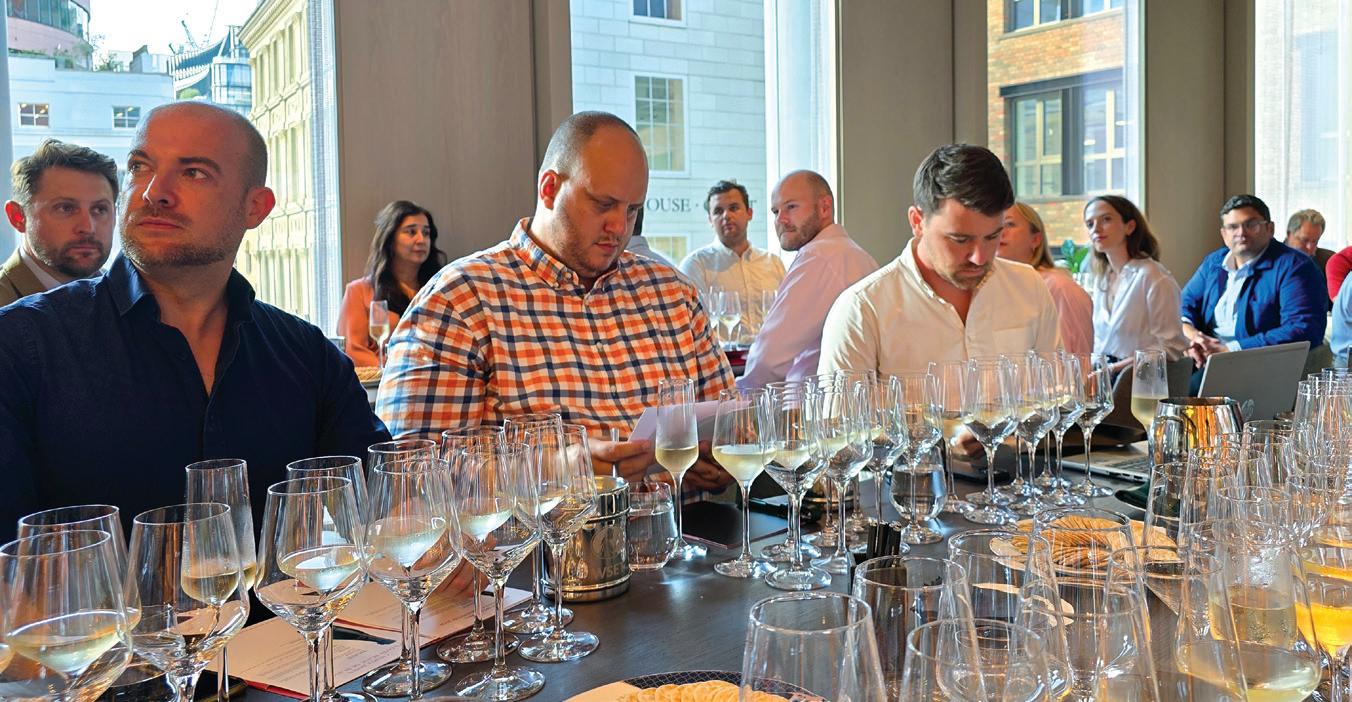



Wine Tours of Kent is founded by Abi Ireland, whose passion for wine was sparked by her time visiting wineries across Australia. This led her to create a business that not only celebrates Kent’s vineyards but also removes the logistical hurdles, like finding a designated driver, that can often come with such experiences. The company is dedicated to making Kent’s wine scene accessible and enjoyable for everyone.
Recently, I had the opportunity to embark on one of these wine tours as part of a press experience day. We visited two entirely different vineyards based in Kent, something Wine Tours of Kent always endeavours to do, allowing visitors to enjoy the diversity of the regions vineyards. We visited Westwell vineyard, and Brabourne vineyard both near Ashford station, where we were conveniently picked up from, although Wine Tours of Kent does offer a door to door collection service within a certain radius.
Our knowledgeable guide Sarah Prior, shared fascinating insights about Kent’s growing reputation as a wine-producing region, and we had the opportunity to taste some truly exceptional local wines. The tour also included a grazing board lunch at Westwell, with local cheeses and Charcuterie, these all paired perfectly with the wines we had just tasted.
What really stood out during the tour was the company’s focus on making wine tourism approachable for everyone. Whether you’re a wine enthusiast or a complete


Alice Griffiths
Alice Griffiths is a wine communicator boosting the profile of English and Welsh Wine on social media, under the popular handle of Posing With Alcohol. Alice has worked within the agriculture industry for the past 20 years, spending time as a lecturer and a smallholder before discovering her passion for viticulture, winemaking and wine tasting.
Get in touch to have your events featured: Envelope Posingwithalcohol@gmail.com
Alice can be found on social media under @posingwithalcohol on Instagram.

novice, Wine Tours of Kent ensures that everyone feels welcome. There’s no pressure to have extensive wine knowledge – the day is designed to be fun, educational, and tailored to each group’s level of interest. This personalized approach is helping to open up wine tourism to a wider audience, making it more accessible to locals and visitors alike.
Beyond their full-day tours, Wine Tours of Kent has recently introduced half-day options, perfect for those on a smaller budget or with limited time. This new offering ensures that even more people can enjoy the Kent wine experience without committing to a full day. They also offer in-house tastings, bringing a selection of Kent’s finest wines directly to your home, holiday rental, or workplace for a private tasting experience.
Wine Tours of Kent’s recent collaboration with Ashford Borough Council and Visit Kent as part of the ‘On the Map’ campaign is further boosting the region’s wine tourism. The initiative, which aims to promote the incredible local produce in Ashford and


highlights how Wine Tours of
is contributing to the growth of wine tourism in the area.
As part of this collaboration, a new digital wine trail map is being developed, along with a dedicated marketing campaign to further promote Kent’s wine industry. These efforts are designed to connect visitors with local experiences, linking together vineyards, accommodation providers, and other attractions to create a complete visitor experience.
Wine Tours of Kent is playing a pivotal role in this movement, helping to showcase the best of Kent’s vineyards and bring more attention to the region’s growing wine industry. Whether through their expertly curated tours or their partnerships with local councils and tourism organizations, the company is helping to shape the future of wine tourism in Kent. For more details on Wine Tours of Kent, check out their website www.winetoursofkent.co.uk or on socials @winetoursofkent
More
detail, more individuality, and more ingredients can, in the right hands, make fascinating wines.
When I assemble a wine lineup for a corporate event, I always keep in mind the diverse palate of the audience. I start with some classic styles and then add a couple of curve balls for that element of surprise. There are always a few quiet wine experts in the crowd who deserve to be wowed by new and fascinating flavours as much as genuine amateurs.
The ‘complex white blend’ is my go-to white wine style to elicit wonder and amazement. I usually head straight to Italy. Top-quality wines from Trentino-Alto Adige and Friuli-Venezia Giulia always come up trumps with their pristine fruit clarity, quirky recipes, and unique flavours. I was reminded of the top white blends from Northern Italy when I recently tasted 2022 Walgate Cuvée M (£39.95, www.brunswickfinewines.com; £39.07 www.sipwines.shop).
Leaving aside the robust price, which might deter experimental drinkers, this wine is a remarkable example of the joys of the complex white blend. It casts a magical spell like my favourite Italians do with its intricate perfume and shape-shifting palate, and I was thrilled to learn it is made from an intriguing collection of lesser-known grapes.
This delightful blending exercise has resulted in a mille-feuille of expressive fruit. Who could have imagined that Müller-Thurgau, Ortega, Siegerrebe, Schönburger and Huxelrebe could sing such an enchanting song?
Ben Walgate recognised this potential, and I have found three more terrific wines this week from three inspirational wineries that prove the offbeat concept that more is more. More detail, more individuality, and more ingredients can, in the right hands, make fascinating wines.
We don’t blink when a red wine fiche technique lists four, five or six varieties, but it is not as common in the white wine world. If one can make a white wine more layered and mesmerising by building strata of flavour, you must go for it.
There is no doubt from my many consumer wine tastings that most punters recognise Sauvignon Blanc, Chardonnay, Riesling and other well-known white grapes. They have flavour memories that anticipate the tastes of wines made from these grapes. But they cannot predict the many nuances and palate gymnastics a clever white blend can offer.

















2023 Greyfriars, Yolande
Still White Blend
£15.00
www.greyfriarsvineyard.co.uk
£17.50
www.hawkinsbros.co.uk
Made from 35% Pinot Gris, 34% Chardonnay, 20% Pinot Blanc and 11% Pinot Noir, this is the UK’s finest value complex white blend!
The Pinot Gris was allowed a two-hour soak, while a quarter of the Chardonnay was fermented and aged in barrel for six months. A couple of other tricks were employed, too, and nothing went through malo to retain as much freshness as possible.
The result is a heavenly creation with an uplifting perfume and a silky, lithe, ever-changing palate. It finishes bone dry, and I venture that anyone and everyone, regardless of vinous experience, in white wines will fall at its feet!
Before you move on to the next wine, it is critical to repeat the value message that all Greyfriars wine trumpet with pride. It is unbelievable just how competitive these wines are, and when anyone moans to me about English wines being too expensive, Greyfriars is my de facto defence!



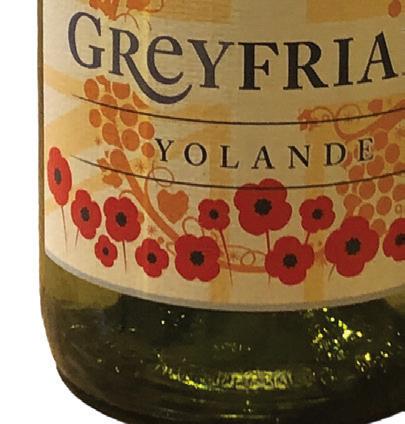

2022 Woodchester Valley Vineyard, Culver Hill
£16.50
www.woodchestervalleyvineyard.co.uk and a wide range of independents, including www.corksofbristol.com www.stroudwine.com www.madeinstroud.co.uk www.eynshamcellars.com www.tivoliwines.co.uk www.givino.co.uk
The folks at Woodchester know a thing or two about complex white blends, with Ortega, Pinot Blanc, Bacchus and Pinot Gris conspiring to create a truly mesmerising wine in Culver Hill.
I have said it before, and it bears repeating that Jeremy Mount is a winemaker with uncanny talent, and every wine in this portfolio is beautifully polished and complete. Culver Hill is the most Alto Adige-like wine of this month’s collection. I think it should be on every dining room table in the land

£30.00
www.vagabondwines.co.uk
In early 1968, Dr John the Night Tripper, on his album Gris-Gris sings, “I walk on guilded splinters”: a song described as a creepy voodoo soup. I listened to this track after Vagabond winemaker Jose Quintana informed me of the inspiration behind this wine, and I urge you to buy a bottle immediately and then turn this awesome music up to 11. As if by magic, this swirling vortex of Pinot Gris, Sauvignon Blanc, Riesling and Muscat makes perfect sense. That’s not to say it isn’t delicious without a soundtrack. Vagabond’s wines have entered a new era with definition, precision and verve, and Night Tripper is one of the finest complex white blends ever assembled in our land. It follows my more is more, complex white blend mantra with every variety playing its part, harmonising with the whole. In addition, I prefer the correct spelling of gilded splinters because, among the heady, floral and pithy stone fruit layers, I can pick up shards of gold in this tremendous wine.

because while it conforms to the classic white wine model of having a refreshing and invigorating nose, a sexy, silky palate and a crunchy, energetic finish (Pinot Blanc brings the acid snap), it does all of this at a wickedly keen price.
The core flavour here is simply stunning – with more fruit notes bringing more excitement, and I reckon that if people could explain, in flavour terms, their perfect white wine to carry out a complete suite of elite white wine duties, Culver Hill would be the answer.



Yorkshire Heart is a family vineyard with three generations working together at this expanding business located between York and Harrogate. The atmosphere created is something truly special.
Like the nearby city of York with the Jorvik Viking centre, the York Minster and the National Railway Museum this vineyard is a fascinating blend of ideas and the results are remarkable.
The vineyard café and shop is situated in the centre of the vineyard so visitors are literally surrounded by the well established flourishing vines. There are currently 26,000 vines covering 15 acres at Yorkshire Heart however this vineyard which is approaching it 20th year started small and has grown from initial inspiration to the thriving vineyard and winery that greets thousands of visitors each year.
Chris and Gillian Spakouskas originally planted 35 vines in their garden but in 2006 they decided to expand their hobby into a
commercial vineyard and the first commercial vines were planted at Yorkshire Heart.
Gillian explained: “My family had a dairy farm and we took on the milk delivery business.” This work started at midnight and finished in the early morning so it gave Chris and Gillian daylight hours in which to plant those first vines. Their Son Tim and his wife Georgina were also there to lend a hand with the establishment of the first parcel of vines. “We still see customers from those days on the milk round and I can remember that they used to order two pints of semi skimmed,” said Gillian with a warm smile.
Gillian pointed out that in those early days she and Chris were also given much emotional support by their own parents. “My dad was

so supportive and he was always happy in the vineyard but he could often be found eating the produce,” she said. Providing the confidence to reach out and try something new is a wonderful gift that parents and grandparents can give to future generations.
Tim and Georgina have two children Henry and Eleanor. Henry has recently completed a viticultural apprenticeship at Plumpton College. Talking about his experience it is clear that Henry gained confidence not just from the educational side of the course but also from the experiences of other students and has made lifelong friends within the industry. “I would like to travel and experience some vintages in different countries,” he said with enthusiasm.

“I think every vineyard should consider working with the apprenticeship scheme,” Chris added.
Working together as a family team may present some challenges but during the day of the visit the harmony between the closeknit group is so evident they almost finish each other’s sentences but still maintain a knowledgeable control over their own specialist area. This working balance seems effortless at Yorkshire Heart and leaves a deep impression of just how successful a family business can be.
Gillian is the head winemaker and current production sits at between 35,000 and 45,000 bottles a year. The wines are available direct from the vineyard but are also sold in farm shops and in local restaurants.
Yorkshire Heart also have an award winning Brewery business with deliveries being made three to four times a week. With a nod to the innovation that is on display across the business, Yorkshire Heart Brewery produce Pinot Porter, a barrel aged beer that utilises the oak barrels from the winery.
The local community is very important to Yorkshire Heart “there is a big enough market so local people can have local produce,” said Gillian. This is in evidence as the family discuss their plans for the upcoming harvest. “We have volunteer pickers most of whom come every year, it is a real community effort,” said Chris with warmth in his voice.
The name Yorkshire Heart was inspired by the location of the vineyard, so close to the exact centre of this wonderful county in the north of England but it is clear that the entire family have a deep passion for growing grapes and producing wine that reflects this unique part of England. Chris does offer another origin of the name, “Gillian is from Yorkshire and I am all heart,” he jokingly said. Chris also recounts a tour on which a group from Lancashire renamed the vineyard simply Heart.
The site is beautifully adorned by lines of mature trees. These not only add beauty to the site but serve as a wind break from the westerly winds. “The Vale of York is very flat and the wind can gather a lot of speed so hedges and trees are used to prevent wind burn of the vines,” said Chris.
When attention turns to the unique challenges of managing a vineyard in the north of England Chris is quick to highlight that it is a common assumption that the weather is a significant issue but Chris and Tim both agree that contrary to popular opinion weather conditions are favourable for grape production.



Georgina has a horticultural background and has scaled back her commercial work to take charge of the vineyard full time. The vineyard sits on an ancient lake bed and the soil is fertile so this requires a lot of effort “controlling vigour in the Solaris and Rondo and opening up the canopy can be a problem,” said Gillian. The vineyard has not suffered from SWD (“we put a no entry sign at the front gate,” joked Tim) nor is there much predation from birds or badgers but both Georgina and Henry point to a boom in the slug population during the 2024 season. This has been especially problematic on the Rondo with the loss of young shoots.
A theme that runs through all the decisions taken at Yorkshire Heart is forward planning. The business is looking not just to the new vines that will be planted next year but to the 19 acres that could be planted in the next decade. “We have grown the vineyard slowly over time because we wanted to really understand the industry as a business to ensure we made good decisions,” said Chris. “We use John Buchan as our agronomist, he actually came to visit our garden vines before we planted the commercial vineyard,” he added with a laugh.
The business is looking not just to the new vines that will be planted next year but to the 19 acres that could be planted in the next decade.
One of the advantages for vineyards that grow slowly is the ability to incorporate lessons learned into the new plots and additional plantings. At Yorkshire Heart this has involved a change to the direction of the planting. Initially the vines were planted north to south in 2m rows but as knowledge has deepened it was suggested that an east to west planting would be better. “That presented a slight problem because we realised that east to west planting would require a 2.5m row if we were to avoid a shadow falling on the fruiting zone,” Chris said. “The vines planted east to west do produce slightly better quality fruit,” Gillian added. Another advantage is that the strong winds now blow along the rows so there is no post damage due to adverse weather.
For independent advice on:
For independent advice on:
Interpretation of soil and tissue
Formulation of nutrient programmes
Interpretation of soil and tissue
Supply of tailor-made products
Formulation of nutrient programmes
Supply of
“We have prepared a couple of hectares ready to plant vines in 2025,” said Chris but the varieties are still under discussion. There are already a vast number of varieties planted at Yorkshire Heart: Acolon, Albarino, Bacchus, Cabernet Cortis, Cabernet Franc, Chardonnay, Divico, Dornfelder, Gamay, Madeline Angevine, Ortega, Pinot Gris, Pinot Noir, Regent, Rondo, Siegrrebe, and Solaris.
This list contains a number of surprises such as Acolon. “It is a very nice vine, that grows well without the need for much control,” said Georgina. Henry too was enthusiastic about the diversity of varieties at the vineyard having worked with varieties such as Acolon at Plumpton. In recent years Acolon has been blended with Rondo to add a depth of fruit flavours to the wine.




“Cabernet Franc ripens properly about one year in three,” said Chris. What the future may bring for this variety is uncertain but a decade ago some growers would have said the same thing about Pinot Noir and yet many growers now harvest fully ripe Pinot Noir every year.
Some of the varieties are planted in small numbers this includes 100 Albarino vines that were planted in 2023. I ask what prompted this planting and Gillian replied: “We have always been told that we can’t do certain things here. Albarino was another one of those things we were told we could not do so we thought we would give it a try.”
Small parcels of vines have also prompted the purchase of a new press for the winery. The new Europress ordered at the Vineyard & Winery Show from the Itasca stand will allow the vineyard to make small run single varietal wines. This investment in new equipment is backed by the building of a new winery area which will double the space the winery currently has. Like the growth of the vineyard the winery too has grown slowly and organically with the new space and equipment meaning there are even more exciting wines on the horizon at Yorkshire Heart.
It is evident that the family team at Yorkshire Heart have embraced the idea of trying new things. Planting traditional if somewhat unusual varieties such as Albarino, Cabernet Franc and Cabernet Cortis has also been accompanied by Piwi plantings. Solaris was part of the initial vineyard planting in 2006. “Ripening earlier and using less inputs I really believe Piwi will become a big part of the wine world,” said Chris emphatically.



<<
There are five wines at Yorkshire Heart that incorporate Solaris and they each showcase different wine styles. As was true in many vineyards across England and Wales 2022 produced a large harvest and this inspired the production of a Solaris Orange Wine. This skin contact white wine had recent success at the WineGB Midlands and North competition picking up the trophy for the best Orange Wine. Solaris is also used to produce a wild yeast low intervention wine. Post fermentation the wine was cleared using Bentonite and the resulting wine has a surprising 11% abv, “this is my favourite of the Solaris wines we make,” said Henry. Tim and his dad Chris enjoy the
Latimer White which is a fresh fruity Solaris wine style. There is also Solara, a sweet wine made from Solaris and fortified with Yorkshire Heart Brandy. The brandy is made by Harrogate Tipple using Seyval Blanc base wine produced in the winery at Yorkshire Heart and is a great example of companies combining skills in order to produce something unique. With the family all taking part in blending “there is a wide range of palates for opinion and we are not making wine for one particular person,” said Gillian who favours the Winemakers
Choice which is a Burgundian oak aged 100% Solaris wine.
The Latimer range includes single varietals

with a red that is 100% Rondo and the 100% Solaris as the white. The name Latimer was chosen for this range because Latimer was the maiden name of Tim’s grandmother and the name Latimer also has a historical connection to the vineyard site. “The Latimer name also helps to keep continuity across the red, rosé and white when people may not be so aware of the Rondo or Solaris grape varieties,” said Tim. This is a valuable point. Winemakers can sometimes raise objections to newer varieties based on the lack of public familiarity with names such as Solaris and Rondo but Yorkshire Heart have created a named range that has inspired trust and the results have started to show. “On a busy Saturday the terrace can be full of people drinking a glass of Latimer red looking out on the Rondo vines,” said Chris. “People who come regularly are getting braver and more adventurous with their choices,” added Tim and Yorkshire Heart certainly have plenty of adventure on offer.
The diverse use of winemaking techniques combined with a desire to innovate (there has been a sparkling red produced for the last four years, a wine style that continues to divide opinion across the wine world) along with the 17 grape varieties provides endless possibilities at Yorkshire Heart. As favourite grape varieties are discussed this ethos becomes ever more apparent as Gillian expressed a desire to make a dessert wine from Siegerrebbe.



•
•
•
•
•
•



The enthusiasm Chris shows is contagious and it is encouraging to note that this attitude must rub off on the visitors that the vineyard welcomes throughout the year. Tim and Chris conduct tours up to three days a week during the height of the season and there are also some tours available to book throughout the winter. With the vineyard located at the very heart of a tourist region it is great to think of the domestic and international tourists that will be getting an informal education around the wide subject of English wine.
There is a campsite on the vineyard and this gives visitors the opportunity to get up close to the vines, wines, beers and spirits (Seyval Blanc base wine is used to create a brandy). Camping on site is possible in one of the luxury glamping tents or it is also possible for tents, camper vans, caravans and motorhomes to be accommodated in a field right next to the vines. The cellar door shop is available for the
guests to be able to enjoy wines made at the winery from the very vines they wake up next to each day of their holiday.
This provision of accommodation has opened the way for the vineyard and brewery to provide a host of experiences including, Acoustic Music Nights and Evenings in the Vineyard with welcome drinks and canapes, a tour of the vineyard and winery and a three course meal. There is also The Hearty Festival which is an annual festival celebrating music and local drinks held over a three day period and for the first time in 2024 The Great Yorkshire Wine and Fizz Festival was held in conjunction with seven other Yorkshire vineyards. For couples and families being able to enjoy these English wine events without having to think about transport home and at a reasonable price is a distinct benefit that is seldom found elsewhere.
The youngest member of the family Eleanor has a red, rosé and white wine that bear her
Yorkshire Heart is a place where family, wine, tourism and community really come together and the harmony that this creates is inspirational.
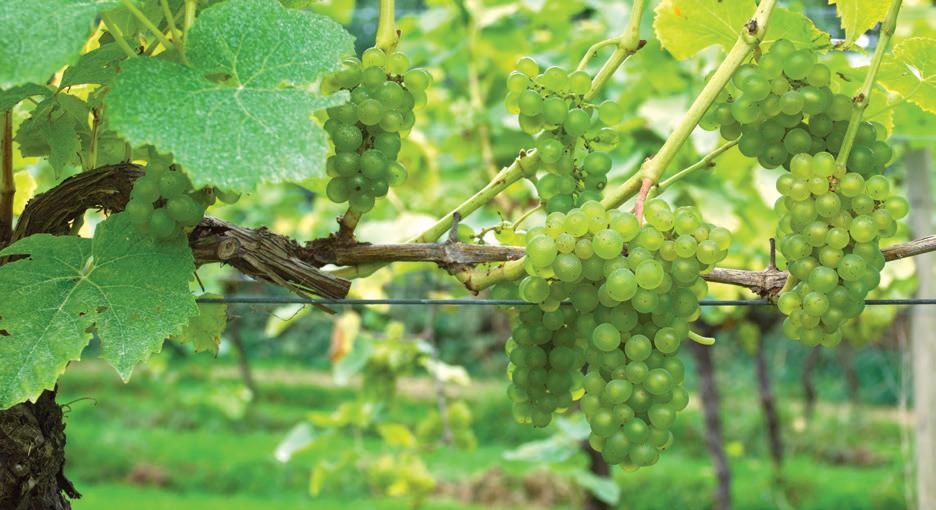
name. These wines are all blends with the red and rosé wine blending Pinot Noir, Gamay and Cabernet Franc and the white wine blending Ortega and Siegerrebe. I asked Eleanor if she intended to enter the family wine business and in a protective manner her grandfather Chris pointed out that there are not many 16 year olds who can answer that question. It was heartwarming to see the quality of love on which Yorkshire Heart is built; that is love for what they do and love for each other.
Yorkshire Heart is a place where family, wine, tourism and community really come together and the harmony that this creates is inspirational. Added to this is a surprising desire for constant innovation both in the vineyard and the winery and the overwhelming sense of making wine an enjoyable experience for everyone. It has often been said that the best wine is the one enjoyed with friends and everyone drinking Yorkshire Heart is in the very best of company.






Agricultural matters
Biodiversity Net Gain
Borrowing against stored wine
Business sale/purchase/transfer/set up
Commercial property sales/purchases/leases
Contracts advice/drafting/disputes
Employment matters
Grape broking/growing contracts
Land sourcing/sales/purchases
Planning permission
Tenancy issues
Wine storage arrangements
So you’ve got the land, the doubts about being a vineyard owner have long been dismissed, your husband/wife/partner have given the enterprise their blessing and the box that your friend Pandora has been keeping for you all these years is well and truly open.
Of course, by now, most of those planning to plant in 2025, and even 2026, will be well under way with their planning. However, there will be some who haven’t made too many plans (or even any), and even though planting is only seven to eight months away, I thought it helpful to look at the basics. Given the importance of getting this part of your vineyard establishment right, I will be spreading this subject over two months. I am starting from the standpoint that the land has already been acquired.
The first task is ordering the vines. You will have done your business plan, worked out what varieties, clones and rootstocks to plant (and in what proportions) and got them on order. Of course, before you do that, you need to know the plantable area, allowing enough
space for headlands, alleyways, loading areas, space for windbreaks etc.
Picking machines are becoming more common in Great British vineyards, and some operators are only prepared to pick if they have sufficient turning area at the top and bottom of the site. I have always allowed at least 9m from the first vine to the boundary and often 10m. Some picking machine operators are now saying 12m is ideal. Remember that your end-post, tie-back and anchor will take up around 1.25m of this space.
How you actually measure the site depends on lots of different factors and also on how accurate you need to be. If you do not intend to fill the field to the last corner, then using a programme on your mobile (such as Google Earth) will give you a pretty accurate answer and as long as you slightly underestimate the area to plant, you won’t have lots of vines over at the end. If pin-point accuracy is required, then ask your planting contractor to help out as they should have a GPS system which is accurate down to 12mm which can work out the area to be planted, vine numbers, row numbers and your whole trellising requirements.


It also goes without saying that your row widths and intervine distance will have been decided by this time, but in case not, here are a few thoughts.
Don’t just fit the row width to the tractor you happen to have, unless that is, it’s a narrow vineyard model. Vine density i.e. the number of vines per hectare, is one of the key factors in getting sustainable yields – by which I mean at least 8-10 tonnes per hectare over a ten-year average using mainstream varieties – and in getting fully ripe, high-quality grapes (and therefore good wine) into the bargain.
The reasons are quite simple to understand. Great Britain still has a cool climate relative to most other growing regions, and excess vigour results in vines being shaded, especially if grown without proper canopy management. Vigour is controlled in part by root competition and the less space each vine has, the more competition there is for nutrients and water, both of which are constant and unrelated to the vine density. That of course is assuming that irrigation is not installed and used.
The research carried out for the ICCWS-WineGB Yield Survey and summarised in the 2020 report, showed this quite clearly. The reports can be found at: www.englishwine.com/harvestreports.php
The choice of rootstock is also one of the keys to helping keep a good balance between fruit and growth, and in suitable soils where high active calcium is not present, low-medium rootstocks such as 420A and 3309C certainly help. SO4, the rootstock beloved by nurseries because of the high success rate achieved in the nursery beds, is often very vigorous in Great British vineyards, especially in the first five to six years.
The later you order vines, the more likely it is that SO4 will be your only option. Using SO4 isn’t a deal-breaker, but it will mean more canopy management. In sites with high active calcium – 20% or higher – Fercal and 41B are your only real options with 41B having significantly lower vigour. The low vigour rootstock 161-49 is also an option in chalky
soils, but it doesn’t suit all varieties.
Grafted vines take around 18 months to produce from securing the scion and rootstock wood, via grafting, rooting, six months in a cuttings bed, lifting and preparing for planting. Ordering vines even 12 months in advance means that you can only order what’s already been grafted and is in the ground. If you really want the right match of vines to your site and soil, ideally your vines need ordering at least 18 months in advance, especially if you want German varieties (including Piwis) for high active calcium, sites.
Of course, all sites are different and there can be no one method of preparation that is right for all sites. The basics however are the same.
Drainage is the first thing to consider on all sites and if the site is at all liable to waterlogging after heavy rain then consider a professionally installed drainage system. Yes, its expensive – £5,000 per hectare for a suitable fruit scheme – but its for the life of the vineyard and will pay dividends year in and year out. Secondly, make sure the site is thoroughly subsoiled down to at least 30cm with 60cm being much better. Over the years I have seen many, many sites where vines are planted into land which is poorly drained and where deep ploughing and subsoiling has not been adequately carried out (or even carried out at all) and in some cases those vines never thrive or give good crops.
Make sure the fertiliser status, including
lime, is adjusted before planting; young vines, which, one must remember, have very small root systems when they are planted, need every advantage in order to put out roots as soon as possible, seeking access to water and nutrients. I know that in recent years there have been some suggestions from the regenerative agriculture brigade that ‘destroying’ a soil structure by deep ploughing and subsoiling is something to be avoided (although it doesn’t stop them advising that regular and structuredestroying undervine cultivation is the best way of keeping weeds under control).
Whatever you do, please do not think that you can plant directly into a grass field, whether or not it has been burnt off with herbicide. I’ve seen it done and I’ve seen the problems that can arise.
If you are planting less than say 5,000 vines you will probably find that hand planting is your only option, although with more planting machines working in GB now, it is certainly worth asking one of the contractors if they will plant for you. Hand planting requires marking everything out correctly and accurately, and digging holes with a decent spade, something like the one I saw in my local garden centre the other day. Please do not think that you can just make a narrow slit in the soil and push the vine in it. That way lies problems. Your vines will be in the ground for 30-40 years and deserve to be planted well.
Machine planting is to my way of thinking
For anyone contemplating planting and establishing a vineyard in the UK, and for those already growing vines on a small scale who perhaps wish to expand their vineyards and improve their winegrowing skills, it will be invaluable. It will also be of interest to students of viticulture. Wine Growing in Great Britain covers not only the viticultural tasks involved, but also, uniquely, the finances of UK wine growing: land costs, vineyard establishment and management costs and the income from both grape sales and wine sales.
much the best way of getting your vineyard established. There is no marking out needed for individual vines, although you will need to establish your initial register line parallel to which all rows will follow, and make sure you leave enough space for headlands (as discussed above).
With the right soils, correct soil preparation and reasonably long rows – say 250 metres – on a good (long) day it is easily possible to plant 20,000 vines with a machine. Steep sites that need planting one way only i.e. not from both ends, or sites with awkward corners and short rows will obviously be slower to plant. However you plant you need to make sure that the holes are deep enough with the graft around 50mm above soil level. The vine’s roots also need to be in good contact with the soil and when planting by machine into clay soils, problems can occur if the planting trench doesn’t close up properly immediately after planting. There are many different ways of planting vines and space in this article limits what I can say about each. The subject is of course covered very comprehensively in my book Wine Growing in Great Britain
Next month I plan to cover the other pre-planting tasks that need to be covered namely the all important task of weed control, what trellising to install and what plans you need to make for looking after your baby vines in their establishment phase.

Soil aggregation, where soil particles bind into stable clusters, is crucial for optimising vineyard health and productivity. Aggregates influence essential soil properties like water management, nutrient availability, and overall soil structure. Improving soil aggregation creates a favourable environment for robust vine growth and sustainable vineyard practices.
Key benefits of soil aggregation
◆ Improved soil structure: Aggregates enhance soil stability and porosity, which improves aeration and reduces compaction. This supports healthy root development by allowing vines better access to water and nutrients.
◆ Efficient water management: Aggregated soils absorb and retain water more effectively. They also are able to drain excess water more effectively. This is particularly beneficial in vineyards in the UK where an excess, rather than a lack, of rain is a major concern.
◆ Enhanced nutrient availability: Aggregates retain essential nutrients like nitrogen, phosphorus, and potassium more efficiently. They create microenvironments that facilitate the gradual release of these nutrients, making them more accessible to vine roots.
◆ Boosted microbial activity: Aggregates provide a habitat for beneficial microorganisms, such as mycorrhizal fungi and nitrogen-fixing bacteria. These microbes play a key role in nutrient cycling and soil health.
◆ Erosion control: Aggregates help stabilise the soil surface, reducing erosion caused by wind and water. This protects soil fertility and productivity, preventing nutrient loss and degradation.
In the UK, maintaining soil aggregation is particularly important due to the region’s diverse soil types and climate. For example, in areas with heavy clay soils like parts of South East England,
improving aggregation helps address issues like compaction and waterlogging. Managing vineyards using systems and practices which enhance soil aggregation and overall soil health is essential. These methods focus on restoring the soil through methods that build organic matter, increase biodiversity, and improve resilience. Techniques such as reduced tillage, cover cropping, and organic amendments support soil aggregation. Adopting these approaches will help UK vineyards improve soil structure, adapt to climate variability, and promote long-term sustainability.
◆ Add organic matter: Incorporate compost, cover crops, and mulch to boost aggregation. Organic matter acts as a binding agent and enhances microbial activity. Cover crops like clover and vetch also contribute organic residues that improve soil structure.
◆ Minimise tillage: Reducing tillage preserves soil structure by avoiding disruption of aggregates. No-till or minimaltill practices support natural processes that strengthen aggregates and maintain soil organic matter.
◆ Implement soil conservation techniques: Use methods like controlled traffic farming, where machinery travel is limited to alternate rows, and buffer zones to prevent compaction and erosion, which results in promoting aggregate formation.
◆ Apply soil amendments: Use gypsum and biochar to improve soil aggregation. Gypsum helps flocculate clay particles, while biochar enhances soil porosity and can increase the

effectiveness of organic matter applications. These amendments also create favourable conditions for soil microbes.
◆ Practice crop rotation and diversification: Rotate cover crops and diversify plant species to boost soil health. Different root systems provide organic residues and support microbial diversity. Crop rotations also help manage pests and diseases and reduce soil compaction.
◆ Use mulching and ground cover: Apply mulch and maintain ground cover to protect soil from erosion and impact from raindrops. Mulch helps retain moisture, regulate temperature, and add organic matter as it decomposes.
◆ Manage soil pH: Maintain optimal soil pH to support soil health and aggregation. Regular soil testing and adjustments with lime or sulphur ensure conditions are ideal for aggregation and microbial activity.
◆ Controlled grazing: In some vineyards, controlled grazing by livestock can manage cover crops and add organic matter. This practice must be carefully managed to avoid soil compaction and overgrazing. Soil aggregation is vital for vineyard health and productivity. By understanding its benefits and implementing strategies to enhance it, vineyard managers can improve soil structure, water management, nutrient availability, and erosion control. This leads to a more resilient and productive vineyard, ensuring high-quality grape production and long-term sustainability.
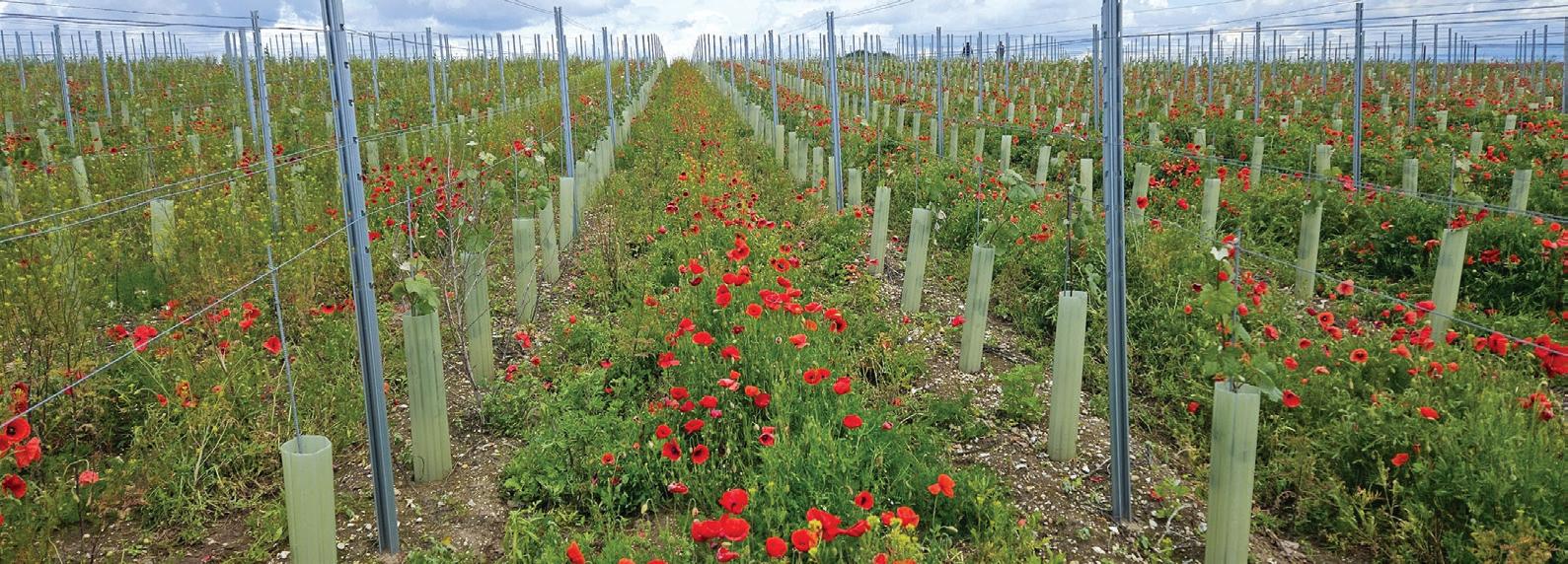

With harvest underway, Hutchinsons agronomists Will Robinson and Megan Fitzpatrick consider what we can learn from a challenging 2024 season.
Unsurprisingly, the weather has been a dominant talking point this year, resulting in mixed fortunes for growers.
Generally, floral initiation was good last summer, so this year’s bunch numbers are similar to normal, but fruit set has been variable, especially where cool, wet conditions occurred during flowering.
In some cases, yields may be 30% down on average, although much depends on the conditions that individual sites experienced during the crucial flowering period. Dry, sunny weather allowed flowering to finish in just a few days, while for some, it went on for a couple of weeks due to poor weather.
The increased incidence of millerandage (‘hen and chick’) this season is typical of poor fruit set resulting from extended flowering periods, but it can also be a symptom of boron deficiency. Take note of where hen and chick has been found, and where necessary, apply boron post-harvest and again from bud burst next year to rectify any deficiencies before flowering commences.
Ironically, where fruit set is lower and bunches are more open, it may help reduce Botrytis pressure in the run-up to harvest, although this could be countered by any increased risk from latent infection that occurred during a protracted flowering period. Latent infection remains unseen within bunches until conditions favour a disease outbreak – notably when sugar levels rise and grape skins thin.
While Botrytis pressure is not unusually high early in September, it is a constant threat later into the season, especially in warm, wet, humid conditions.
Disease often flares up on damaged
grapes, including those where flower caps stuck to embryonic berries earlier in the season, creating a fracture point as grapes mature – something we have seen this year.
Some cracking has also been observed, possibly caused by the rapid growth that occurred when the weather warmed up in late July and August. Calcium is pivotal to skin strength, and while it is usually readily available in the soil, plant uptake and utilisation of the large molecule can be slow, therefore vines sometimes struggle to meet rapid increases in demand. This highlights the value of regular nutrient testing to identify potential issues early, and to apply foliar calcium at key times to boost levels when required.
With strict harvest intervals on conventional botryticides, it can be tricky protecting crops right up to harvest, although biological products based on beneficial micro-organisms and enzymes can mitigate this. They are very much a preventative measure though, with populations requiring time to build up, so any such approach should be planned in good time next season.
Disease-wise, powdery mildew has been problematic in some parts of the south, but the biggest challenge for many in such a wet season has been downy mildew control, first appearing towards the end of May and requiring a concerted focus to protect mature leaves right up to harvest.
Given limited chemistry, downy mildew is virtually impossible to eradicate once it gets into a crop in seasons like this, so the focus is on managing the risk of disease spreading. Interestingly, more infection pressure has


been noticed on the laterals of primary shoots this season, particularly where growers stayed with a fixed two-week spray programme. In such situations, any growth emerging soon after treatment, may have been left exposed for the best part of two weeks before being treated. It highlights the need for flexible spray timings based on forecast conditions and disease risk, and perhaps in future highrisk situations, consider an intermediate treatment (e.g. sulphur + copper) mid-way between conventional treatments to maximise protection.
Growers also need to be aware of any potential disease carryover into next season. Where possible, consider applying a specific downy mildew fungicide alongside the post-harvest copper foliar feed, to minimise carryover risk on fallen leaves and other material.
Enhancing soil biology could also help manage overwintering oospores, as many species of fungi act as biocontrol agents, consuming or destroying disease spores in the soil.
As the UK area of vines continues to increase, so we may find greater risk of disease inoculum spreading between sites, especially wind-blown spores in areas where vine growing is more concentrated, and growers employ different treatment regimes. More open communication between groups of local growers could help everyone identify and act on risks in a more timely manner, whether those risks are diseases, pests, or other threats, such as frost.




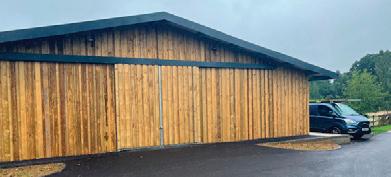












































































































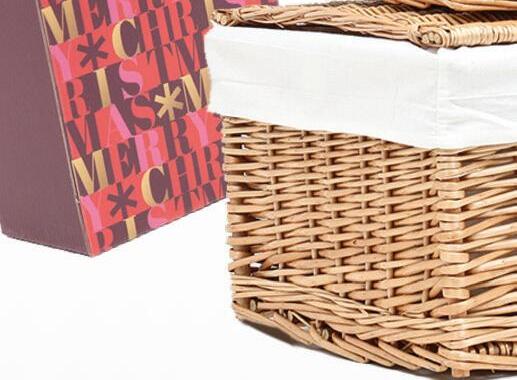


































































































Let’s not beat around the bush, winemaking involves a lot of liquid. Keeping that liquid contained, monitored and controlled is a fundamental part of the process. It’s important to know your tanks so that you can select the appropriate vessel for your winery’s size, style and scale.
For those approaching the subject for the first time, there can be a bewildering array to choose from. Materials might include stainless steel, concrete, oak, plastic or even clay. Each comes with its own advantages, disadvantages and price tag. So how does one negotiate the tricky business of tank selection?
◆ Look at vineyard size and predicted production volumes. Not only do vessels need to be able to accommodate all of the juice produced at harvest, but consideration needs to be given as to how this will be divided up by style.
◆ This leads us on neatly to style and quality considerations. Different materials offer the potential for different outcomes at the end of the process. Stainless steel is perhaps the most common and relatively cost-effective material, leading to crisp, clean wines. Oak vessels come at a significant price but can add more complex layers of flavour to the finished product.
◆ For some winemakers, environmental impact and sustainability are at the heart of their working practices. For them, the environmental impact of their tanks –how they were produced, how energy efficient they are and how recyclable they
will be at the end of their life – can be a critical factor in selection.
◆ I’ve alluded to the price already, but it isn’t just the upfront costs that need to be considered. Maintenance and the longevity of different tank types also need to be factored in so that an informed investment can be made that will keep the business in good shape over the years and decades to come.
Let’s look at some of the different types of tanks that are available in more detail. What do different materials add – or take away –from the finished wine?


Stainless steel has become the industry standard. It’s an inert vessel, easy to keep clean and relatively affordable. But sometimes, a pure expression of the fruit isn’t all that’s required. Some winemakers look to add depth and complexity to their wines by blending liquid fermented in a range of materials.
In Hampshire, the Grange Estate’s Classic NV English Sparkling Wine is fermented 86% in stainless steel tanks and 14% in old oak barrels before undergoing a 33-month lees ageing process in bottle. The Grange Estate have recently moved into their own newly-built winery facility. Until 2022, their vinification took place at Hattingley Wine Estate, but now winemaker Harry Pickering has greater control over the vessels he sources and how he uses them to achieve the depth and complexity of flavour he is looking for.
“We ferment a bit of everything in barrel as well as in tanks. It gives you two different components to play with from the same fruit. For us, we find anywhere between 80% to 90% for the stainless steel tank fermentation is where things sit nicely.
“The tank components are the bones of the wine when we're looking at blending, that's the main structure. The fruit components are more obvious and it’s more structural in terms of acidity. By fermenting in tanks you get the pure expression of the fruit because they are in the most inert vessel and completely unadulterated.
“On top of that, you start to layer the oak. The majority of the oak we've used up until now is old oak, fourth fill. Those barrels come from a Tonnellerie in Champagne. They sell Champagne barrels to producers in Bordeaux and Burgundy. After they've had the yeast in them for four years fermenting white wines, they take them back and distribute them out to people who want older oak. The reason for going through this Tonnellerie is purely a reputational thing more than anything, in terms of knowing that the oak you're going to get is being properly quality controlled.
You’re trying to limit any spoilage or microbes being in that wood, so you need to know the provenance of the old oak to limit the risk of contamination.
“The idea is not to impart those oak tannins and give the wine an oakiness. It's more about the micro oxygenation that you get from the oxygen being able to permeate through the wood during the ferment and ageing, compared to a stainless tank. In a barrel, there is a lot more surface area of the wine in contact with the yeast lees and the surface area of the barrel itself. That allows for more exposure to oxygen and more exposure to the dead yeast at the bottom of the barrel post fermentation. In turn, that leads to autolysis and the breakdown of the yeast. The mannoproteins that you're getting from the dead yeast soften the wine and add those soft and buttery autolytic characters.
“So the old oak softens and it broadens the palate. That’s adding the flesh onto the bones. We find that between 10% and 20% in old oak is where that sits nicely. It’s about the balance between softening the wines, but still having them maintaining their structure and core personality. They're not becoming overly flabby, just softening and rounding out the palate.
“Since we've had the winery, we are beginning to play a bit with new oak, which adds a third dimension to the whole thing – almost like the accessories that are added to clothing. But the amounts that we are adding are so tiny that you can barely perceive them. We only add about 1% to 5%. It ripens up the fruit and makes the wine a bit more serious. It's almost like turning the volume up a bit. It's not about changing it dramatically and making an oaky wine, it's about adding a bit of perfume, that little bit of personality at the very end.
“Because this is a new thing for us, we’re still working out which Tonnellerie suits our needs. Each year we’re going to use a new one, look at their barrels and see how they work for us. Then we’ll hopefully end up with five or six different Tonnelleries’ barrels in
the winery over the next few years, that are toasted to different degrees, and increase volumes depending on who we like most. I imagine it will always be a range of them because they will offer different things and it’s useful to have that diversity for blending.”
Clayver produces oblong or spherical stoneware containers of various sizes used for the fermentation and refinement of wine. It is becoming more common to see spherically shaped tanks, because this reduces the overall weight of the vessel and also encourages the natural convective movements within the liquid as it ferments. It also arguably has benefits when cleaning the vessel.
Clayvers have a very high firing temperature and are claimed to contain fewer metal ion contaminants than more established clayware containers. There is still a porous character to these tanks that allows a controlled amount of oxygen into the wine during ageing, but they are less porous than terracotta, for example.
Concrete has been in use for fermentation for over a century, but fell out of favour as stainless steel became de rigueur. Concrete has the same inert qualities as stainless, but is also thermally consistent – taking a long time to heat up or cool down. This provides a stable environment for the yeast to slowly work its magic. This natural insulator is therefore also suitable for storing and ageing wines.
Unlike stainless tanks – and to some extent in common with wood – concrete tanks can impart a degree of flavour to the wine, a delicate mineral character. But primarily, it lets the fruit shine. No flavour is removed or masked by the vessel.
Concrete can be formed into virtually any size or shape. Square and rectangular tanks are quite common, but conical shapes are also possible. They can be built to order, to include valves, gauges and hatches wherever you should wish them to be placed.
As vinification technology moves on, more advancements are being made in so-called smart tanks, which have sensors and automated controls to monitor and adjust temperature, pH and other variables in real time. An automated temperature regulation system might be used to control the temperature of the fermenting wine, reducing the risk of human error inherent in the monitoring of manual shut-off valves, for example.
Sonoma’s VinWizard was given an award for innovation in 2023 by the Wine Industry Network for their Multi-Sensor Probe (MSP). Building on the success of the Multi-Level Probe (MLP) which was released a decade ago, which measures the temperature of the entire tank, the MSP is able to provide real-time Brix measurements during fermentation. This is intended to overcome the inefficiencies that come with manual sampling, as well as the time it takes to gather multiple measurements throughout fermentation. The probe runs from the top to the bottom of the tank so provides multi-level Brix reading alongside the most accurate reading of temperature at the core of the tank without interfering with other mechanisms.
Having this data helps to visualise the fermentation that is occurring in each tank. It gives early warning if fermentation stalls. The technology can also be set up to work in combination with automation platforms to trigger various fermentation and winemaking processes if necessary – making adjustments to temperature or starting a pump over cycle, for example.
Research is also underway to automate microbial monitoring. Classical methods, like cultivation on plates, and even more recent technologies like flow cytometry can take a lot of time and not sample at the optimum frequency. The laboratory tests used an online flow cytometry system with a protocol for automating sampling, doublestaining and analysis. The researchers assert that such technologies could be “particularly useful for facilitating and improving control of potential contaminants or stuck fermentations, as well as better piloting starter preparations, alcoholic fermentations, or malolactic fermentations.”


While the researchers are confident that their methodology shows promise, time will tell whether it can jump over the line into a commercially available solution that allows winemakers to monitor bacteria and yeasts over a long period of time and with high frequency testing that will provide a high resolution of data to the winemaker. Of course, automation comes with a significant price tag. When considering the potential return on investment, it is important to look at the compatibility of new technologies with existing processes. There may be a technical skills gap within the workforce and proper training must be delivered so that automated solutions can be used properly and to the best advantage.

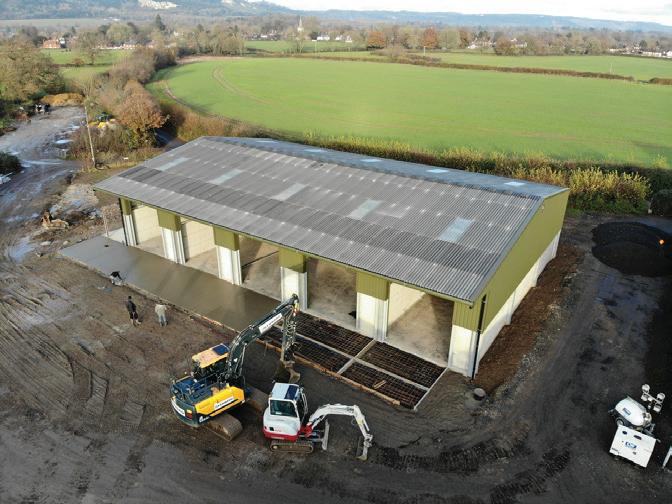











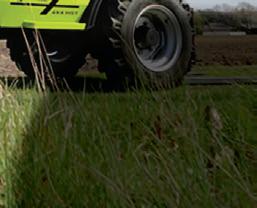














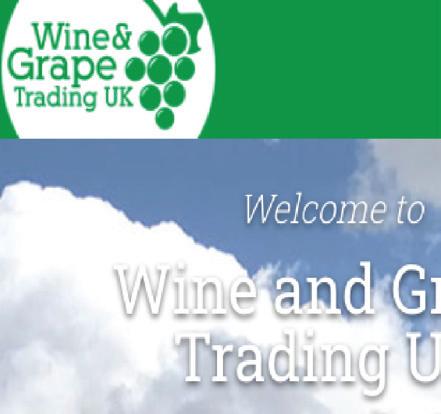

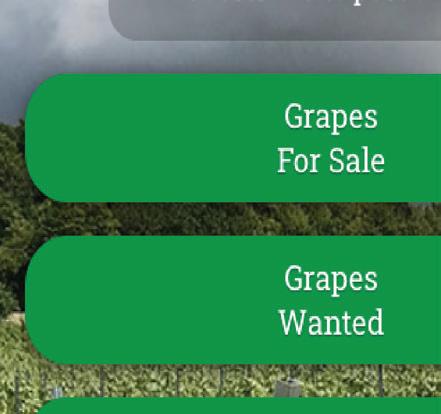




Core Equipment have been supplying wineries in the UK for well over a decade. They can supply anything from a pump through to a press, to a full winery set up – covering the whole winemaking process. Vineyard magazine tapped into that expertise to find out more about some specific technologies that can assist in producing wine at the highest levels of quality.
Dan Tomlin from Core Equipment kindly shared his insights into some of the more interesting technologies on the market right now.
As the UK wine market gains more expertise and winemaking know-how, fermentation control becomes more important to ensure the production of quality wines. Whether simply maintained at low temperature or regulated to allow for
efficient fermentation, adding a temperature control system to winery tanks is essential.
Coolant supply can be discreet, provided by a network of stainless-steel pipework, pressure regulation systems, individual or centralised tank temperature control and remote access, to monitor the temperature. Core Equipment has installed over 25 full fermentation control systems across UK wineries and with this experience and technical knowledge of the fermentation process comes quality wine production.
Homogenous temperature is a critical detail of quality winemaking. A heated liquid is lighter than the same liquid at a lower temperature. With the heat source being located at the bottom of the tank, the convective flow will rise throughout the entire fluid and self-mix with the cooler fluid resulting in a very even temperature which couldn’t otherwise be achieved without mechanical mixing.

Letina INOX tanks, exclusively supplied by Core Equipment, can be made to suit any tank dimension, whether tall and narrow or wide and short, further enhancing the convective flow of liquid within the vessel. The rising warmer fluid leaves room for the cooler fluid which will take its place. This keeps the delta differential at its best level; reaching target temperatures more quickly. With sustainability more relevant within the winemaking process, the result of faster and more accurate temperature control reduces energy consumption thus reducing the carbon footprint of the winery. Typically winery tanks are supplied with a simple cooling/heating jacket around the circumference of the tank, however, with the bespoke manufacturing process of Letina INOX tanks, jackets can be added to the underside of vessels, facilitating quicker temperature regulation and stabilisation process.
The positioning of these jackets ensures that temperature is being passed through the liquid, whereas with conventional tanks, we often see jackets simply heating the

air within a tank. Heating a juice after cold settling, malolactic conversion allowing lees suspension, or of a red wine during alcoholic fermentation without overheating the cap are often key drivers to selecting this approach.
Compartment tanks, also known as multi-chamber tanks, are becoming more commonplace in UK wineries this type of winery tank allows winemakers flexibility when it comes to juice storage.
As yields vary from harvest to harvest, the compartments provide for the storage of different juice varieties without compromising on quality. The tanks optimise winery space, with often three or more compartments within one tank, meaning valuable floor space is not lost to rows of tanks. For the contract winemakers in the UK, this allows different varieties to be stored, settled and fermented in compartments designed to take smaller yields, where full tank space is not required.
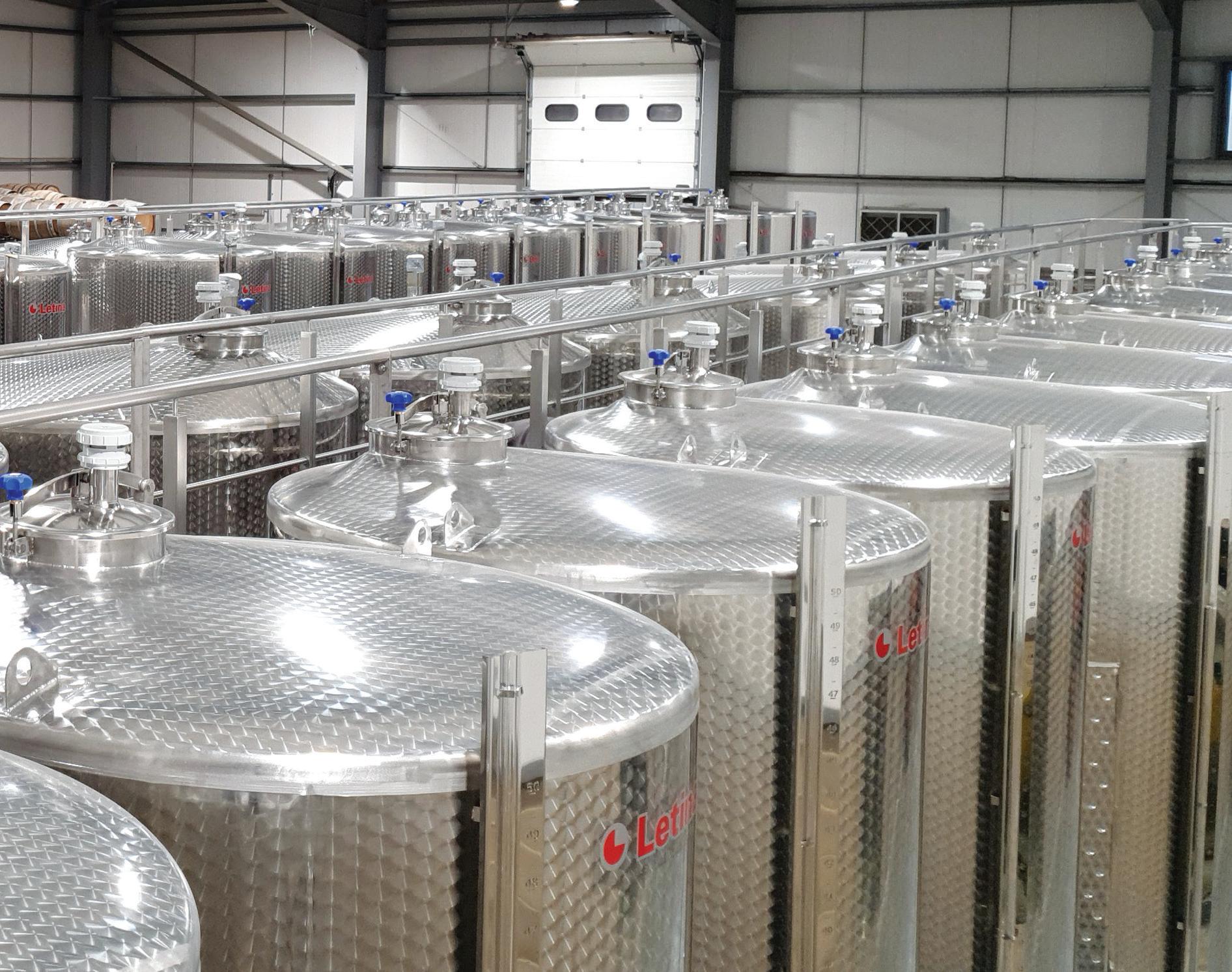
Nene Valley Winery, a collaborative venture by two families in Northamptonshire, officially opened on 29 August 2024.
The state-of-the-art facility at Nene Valley Winery combines cuttingedge technology with traditional craftsmanship, aiming to enhance the region’s growing reputation for winemaking. The founders envisioned a winery that delivers high-quality winemaking services to vineyards across the UK, reflecting a deep connection to the local land. Their model blends expertise, innovation, and customercentric service to set a new standard in the industry.
Strategically located in Northamptonshire, the winery benefits from its central position in the UK, providing easy access for vineyards nationwide. This proximity reduces the time between grape harvest and production, helping to preserve the quality of the grapes. Clients can also choose to be closely involved in the winemaking process, from start to finish.
Leading the winemaking at Nene Valley Winery is Salvatore Leone, an internationally renowned Italian Winemaking Consultant with over 20

years of experience and 34 vintages across seven countries. Salvatore Leone has honed his craft in the UK for the past eight years and is known for producing wines of complexity and elegance. His approach to winemaking is deeply personalised, tailoring each project to reflect the unique qualities of the vineyard and the client’s vision. This attention to detail ensures that each bottle reflects the client’s ideas and the grapes' full potential.
Strategically located in Northamptonshire, the winery benefits from its central position in the UK, providing easy access for vineyards nationwide.
















What sets Nene Valley Winery apart is its commitment to client involvement. The winery provides an advanced software platform that allows clients to monitor the progress of their wines in real-time, communicate with the winemaking team, and make key decisions about fermentation and blending. This transparency and collaboration are rare in the contract winemaking industry, making Nene Valley Winery a standout facility.
The winery operates under a contract-only model, offering services exclusively to vineyard owners rather than producing its own labels. This model is especially appealing to smaller vineyards and entrepreneurs who may lack the resources or expertise to manage the entire winemaking process. By outsourcing production to Nene Valley, clients can focus on growing their grapes while the winery handles the technical complexities of winemaking.
Nene Valley Winery’s cutting-edge facility, developed in partnership with Core Equipment, is designed to ensure precision and quality at every stage of production. A partnership established two years ago with the assignment to create one of the leading contract wineries in the UK. The expertise from the team at Core has meant that the winery has the latest equipment. The facility features high-tech stainless steel tanks with temperature control systems for optimal fermentation. The grape intake starts with world leading Zambelli elevator and de-stemmer followed by the state of the art Bucher press. The winery’s software further enhances the process, allowing clients to track their wine’s progress and collaborate with the team throughout.
In addition to winemaking, Nene Valley Winery offers a full range of services, including bottling, labelling, and distribution. The facility can accommodate a variety of bottle sizes and labelling options, allowing clients to customise their products to their exact specifications.
For small vineyard owners, this all-in-one service is invaluable, streamlining the process from grape to market while ensuring that the wines meet the highest quality standards.
With its innovative approach, strategic location, and dedication to client service, Nene Valley Winery is set to become a major player in the English wine industry. The contract winemaking model offers a new pathway for vineyard owners to produce top-quality wines, helping elevate the profile of English wines on the global stage. As the industry continues to grow, Nene Valley Winery will be at the forefront, supporting the success of vineyards across the UK.
Nene Valley Winery’s cutting-edge facility, developed in partnership with Core Equipment, is designed to ensure precision and quality at every stage of production.















































































































Working in partnership with Vineyard magazine for a developing UK wine industry.
WineGB is the national association for the English and Welsh wine industry. WineGB represents, leads, and supports the sustainable growth of the Great British wine sector.
If you are interested in wine production in the UK find out more about WineGB and join us. Visit our website www.winegb.co.uk
The GB wine industry is the fastest growing agricultural sector. We call for:
Last month, we sent in our second Budget submission of the year and wrote to the Chancellor of the Exchequer, Rt Hon Rachel Reeves MP.
As the UK’s fastest growing agricultural sector, we called for:
Duty reform and fairer business
◆ A fairer tax regime for British wine including a duty reduction/freeze. The UK is one of the few wine-producing countries in Europe that levies excise on home-grown and produced products. 10 European countries apply no excise duty on domestically produced sparkling wines (France only applied a rate of €0.07 in 2022), while 15 applied no excise duty on domestically produced still wines (France applied rate of €0.03). This is the reality of what English and Welsh wine competes with both domestically and internationally. Reducing duty on wine would help stimulate sales, which in turn could deliver a knock-on increase in collected excise duty.
• Cut/freeze duty rates
• Support tourism –cellar door relief
• Small producer relief
• Education –Future Winemakers Fund
• Production –viticulture and winery
• Cellar door support
• Research
• Export partnering
• Tax-free shopping for third country nationals
• International arrivals duty-free
◆ Support for wine tourism in the form of Cellar Door Relief, supporting 300 businesses to grow their tourism offerings.
A quarter of winery income on average comes from wine tourism in the UK.
According to the 2021 South Downs National Park report, viticulture has a 13 times higher gross value add to the economy compared to traditional cereal crops.
A Cellar Door Relief Scheme would allow producers to claim relief on sales of up to 13,350 bottles from their cellar door. Such a scheme would support local tourism and community spaces, provide additional job opportunities, and boost sales, leading to increased revenue for the Treasury.
◆ Extension of Small Producer Relief to level the playing field and ensure English and Welsh wine producers – as well as small brewers and cider-makers – can access this support.
As it stands, wine is excluded from SPR due to the 8.5% ABV threshold imposed.
The International Organisation of Vine and Wine (OIV), of which the UK Government is a member, states that wine cannot be made under 8.5% and still be called wine.
We propose that SPR be adjusted so that it has alcohol category specific thresholds which would enable domestic wine producers to avail of it by producing products to the lower end of the recognised wine ABV scale i.e. 10.5% to 11.5% ABV.
◆ Backing for education by making the Future Winemakers’ Scheme a permanent, annual funding stream. Making this Scheme, announced in April, an annual initiative would boost education and expertise within our industry and reduce dependence on overseas talent.
◆ Enhanced grants for both vineyard and winery related equipment, allowing for improved productivity and sector-wide investment.
We propose that future iterations of the Farming Equipment and Technology Fund include more viticulture-specific equipment, while grants should also be given for production-related machinery and infrastructure. This would address the potential lack of production facilities (221 wineries, compared to 1,030 vineyards) in the face of increased harvest volumes.
◆ Cellar door support by enhancing local infrastructure to facilitate travel and communication.
Improved physical infrastructure (transport links, energy, water, wifi etc.) would support the growth of both our sector and the wider rural economy.
◆ Further aid for wine-specific research to help us face challenges brought about by climate change. Further support for winemaking-specific research is required so we can help our industry mitigate the effects of variable weather patterns and develop new techniques to process different grape varieties.
◆ Export support and partnerships to increase market penetration overseas. Only with substantial UK Government assistance, working in partnership with our sector to open doors, will this be possible.
Exports of English and Welsh wine have doubled in two years (4% in 2021 to 8% of total sales in 2023). For new and emerging businesses, the export market can be challenging, and our industry requires the active support of the UK government through programmes such as the UK Embassy network as well as grant and export financing.
No alcoholic beverage category and no new wine region has established itself internationally in the last 50 years without such assistance.
◆ Restoration of tax-free shopping for international visitors to the UK. By making this change, it would expose UK wine producers to an expanded customer base. Such a measure has the potential to create a £10 billion, shopping-led tourism market for Britain as well as generating a positive economic impact for regions outside of Greater London.
◆ Introduction of arrivals duty-free at UK ports and airports to provide travel incentives.
Over 60 countries world-wide allow arrivals duty-free, including Norway and Switzerland. Arrivals duty-free relocates passenger spending from the point of departure to the point of arrival. It would benefit UK producers, given the importance of selling locally produced products, in particular in regional airports and the UK’s ports.
26 September 2024
WineGB webinar on Asian Hornets, 4pm
23 October 2024
WineGB Sustainability Report Launch
20 November 2024
Vineyard & Winery Show in conjunction with WineGB
WineGB membership entitles you to a free consultation with WineGB Silver Patron Bevica. Bevica is an end-to-end business management solution that offers operation and finance teams a platform to track inventory, production and compliance, supply chain and warehousing, cost control, sales, eCommerce, and CRM with KPI insights as standard. Visit the WineGB website and apply online to experience our range of benefits.
An investment resulted in a Dropbox link to 2,500 technical plans for a range of machinery that Rob Burr knew from experience was some of the best on the market.

Rob Burr describes himself as “not a gambling man”, but risking 1,500 Euros on the drawings for a range of quality vineyard equipment when the Italian manufacturer ceased trading proved to be a good bet.
The investment resulted in a Dropbox link to 2,500 technical plans for a range of machinery that Rob knew from experience was some of the best on the market. Using his own expertise to make a number of improvements, he now includes those pieces of equipment amongst the Voxx Machinery range he manufactures at Marden in Kent.
“It was a bit of a gamble,” he confessed.
“When I knew the company was going out of business, I emailed the address on the website and asked if I could buy the drawings. I didn’t get a reply for quite some time and in the meantime the website was taken down.
“Eventually someone got in touch and quoted me 1,500 Euros. I asked what I would be getting for my money, but they weren’t very forthcoming, so I just had to trust to luck.”
The new machinery, which included vine trimmers and deleafers amongst other “solid and reliable” equipment, was a useful addition to the Voxx Machinery range, which also features items Rob has designed from scratch and builds at Marden with the help of skilled craftsmen Tony Harris and Harley Harryman
In an earlier but equally astute move, Rob had already bought the drawings for the renowned Port Agric range of machinery when that company went out of business, again making a number of tweaks aimed at “making great quality machinery even better”.
The increasingly popular Voxx Machinery range now includes an in-house designed strimmer and side-discharge flail mower, a direct drill for sowing cover crops amongst the vines, a vine trimmer, a de-leafer and a modular bud rubber that can be quickly and easily adapted to suit different canopy heights. The combination of his own expertise and
an eye for building on existing designs has seen Voxx Machinery pick up an appreciative customer base in vineyards looking for wellbuilt, reliable equipment. “Our equipment is built to do the job for the next 20 years, not the next five,” said Rob, whose grandfather Bert farmed at nearby Wanshurst Green Farm for 65 or so years.
The farming bug skipped a generation, but Rob spent much of his childhood with his grandparents and picked up a love of farming in general and machinery in particular, something which fascinated him as a child and still inspires him to find a better way of tackling problems as an adult.
Despite his background, his first venture was setting up a car body shop which specialised in respraying high-end vehicles, after which he obtained his commercial pilot’s licence and flew for a living for 10 years.
It was after marrying his first wife Harriet that he returned to the world of agriculture, setting up a tractor dealership under the Pinks Agri brand and supplying machinery from Zetor, Vicon, Twose and Opico amongst other brands.
The sad death of Harriet in 2015 saw him stop and take a breath, but by 2017, he “got itchy feet”. Looking for a new challenge, he bid for, and won, a grant to develop a ‘proof
of concept’ for a battery-powered all-terrain mower that would be suitable for areas such as paddocks.
Successfully completing that project re-ignited his love of machinery, at which point he bought the drawings, and Voxx Machinery, part of Pinks Group Ltd, was born.
“I have always been fascinated by machinery and I am lucky enough to have been born with a good degree of common sense,” Rob said. “I can look at something, understand how it works and figure out how to make it; more importantly, I can often see how to make it better.
“While I love machinery, I never wanted just to be an engineer, following someone else’s instructions. I like to be in at the start and create something, to build something from nothing. I really enjoy what I am doing now and only wish I had started up the business ten years earlier.”
Along with a range of vineyard machinery, Rob has created a flourishing business which will once again be meeting customers old and new at this year’s Vineyard & Winery Show on
20 November at the Kent County Showground. Voxx products are sold both direct to the grower, which helps keep prices competitive, or via select dealerships. The range is continuing to grow, while the company itself has grown steadily over the past seven years.
Rob has had success most recently with his new undervine strimmer which doesn’t disturb the soil and reduces the need to use chemicals to tackle unwanted vegetation. More importantly, his unique design means both heads on the strimmer can be re-corded and back in action in around 15 minutes.
“Given how long it normally takes to change the heads on a strimmer, the Voxx Machinery model can save hours of labour, and since time is money, that can amount to big savings for the grower,” he commented.
The side-discharge flail mower, another popular Voxx Machinery product, is another of Rob’s own designs that is building a fan base amongst growers. Currently made to order in the workshop, the plan now is to build up stock over the winter so that the mowers will be available from stock for 2025.
Voxx machinery was founded in 2017, seeing a gap in the market for UK built machinery offering strength and reliability. Machines are fully manufactured here in the UK. Our aim and passion is to manufacture machines to not only be stronger and durable than others. We offer a specialised range of machines catered specifically for fruit and vineyard application. These machines are able to be adapted to differing row widths, addition of items such as wheels, rollers, hydraulics and heavier rotors to suit.

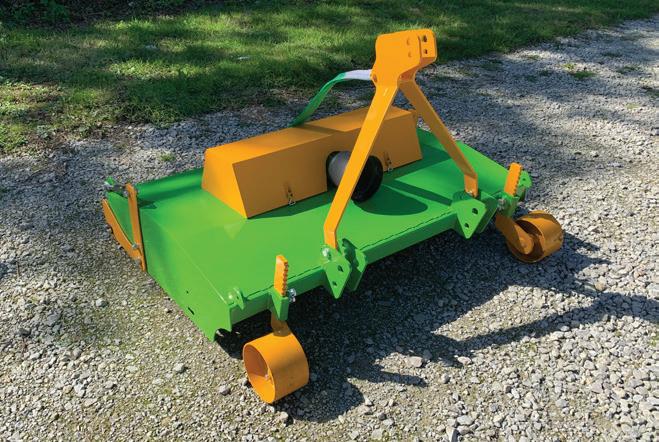



















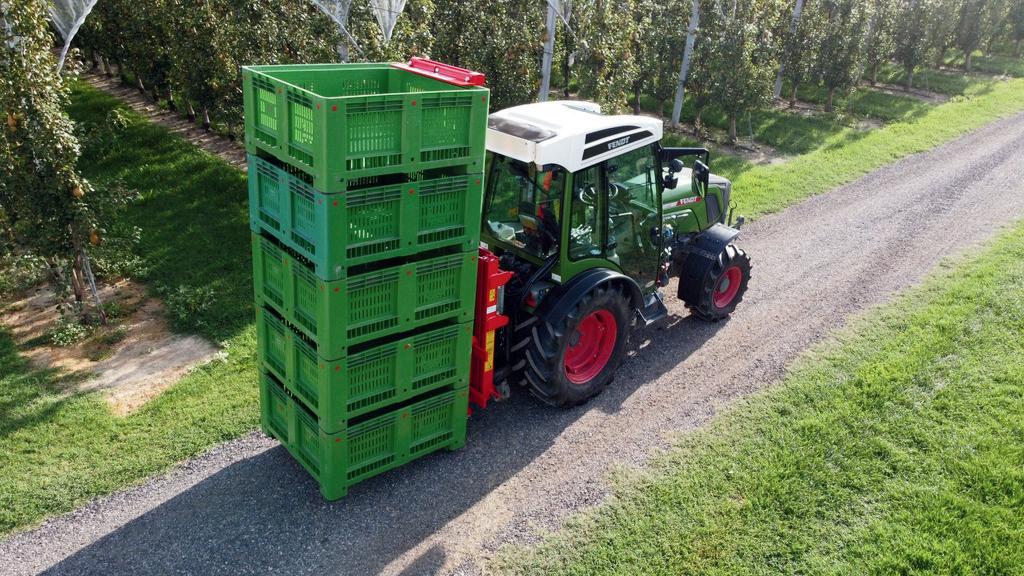




















As farmers and growers continue to pursue the perennial challenge of improving soil health, be it for no-till / regen approaches, carbon retention and credits, yield productivity or Government funded schemes, many new and innovative products and approaches are being utilised.
Along with these products and approaches, an understanding of the fundamental requirements for tyre selection has never been more critical according to Bridgestone’s Sales Manager Stephen Lamb, who believes that thousands of pounds worth of crop yield is being lost as a result.
He is now urging growers and contractors to make tyres a priority consideration, rather than an afterthought, as can often be the case.
Stephen said: “We need to care for our soils, but one critical factor is often overlooked and that is correct tyre selection, along with a need to understand the basic fundamentals. Correct tyre fitment ensures that tractors and machinery make contact with the soil as kindly as possible, while at the same time performing an efficient application.”
“Too often we see good intent to improve soil health, but tyre considerations are still much lower down the list of prioritised items. The weight and movement of tractors and machinery across the land is a real contributing factor to soil compaction, soil disturbance and yield reduction. This all impacts on a business’s bottom-line. Not only is it important to understand this, but it must be acted upon in order to appreciate the significant benefit gains.”
“If you were to invest the same amount of time, you put in to say, selecting the optimum choice of implements for your soils, or the optimum seed varieties, you would see a positive return on that investment. So, the consideration of optimum tyre selection should be adopted as standard practice, especially when talking with your salesperson.
“Yet in many cases it is not. How often do you see an expensive new SP Sprayer sporting rowcrops of a non-VF specification, meaning the sprayer will have a much
greater negative impact on the farm’s soil, for the whole time the sprayer lives on that farm? Another example is a new tractor fitted with 900s, because we want to protect the soil. This is great, but with a small amount of research, maybe VF710’s could have been a much wiser choice?”
Stephen added: “Firstly, we don’t want to go onto the land, but wherever we need to move soil or cut through it, an anchor-point (footprint) will need to be established. With the anchor-point being the soil’s enemy, we need to make sure it’s as restricted as possible, but still capable of its efficient function.
“To help restrict it, look at increasing its length, which could in-turn help in reducing its width and reducing the tyre to field contact
percentage. We want to have the lowest anchor-point operating pressure/ground pressure with the narrowest tyre to carry-out the application.
“Also look at achieving the highest optimum travel speed. The less time the anchor-point is directly in contact with the soil at any one moment is beneficial to reducing the degree of compaction generated. The less amount of compaction generated, the less the amount of costly eradication is needed thereafter.
“Once we understand these fundamental benchmarks of any field operation, we can then go on to seeing what tyre sizes and specs will best represent those benchmarks, within the framework of the tractor and its application.”










While we are huge advocates of mechanical harvesters, such as the ERO Grapeliner 7000 series we will be demonstrating in a few weeks, we recognise that not all fruit is suitable for machine harvesting, and the majority of English and Welsh wine producers will continue to harvest by hand.
Thankfully, a range of modern equipment is designed to make life as easy and efficient as possible for those hard-working grape pickers.
One of the most crucial aspects of harvest time is planning the most effective way to get fruit from the vineyard to the winery.
Our vineyard picking trailers manufactured by Agrofer have been specifically designed for carrying bins of grapes, making easy and light work of those harvest logistics.
The ‘ECO’ bin trailers have a roller track chassis to allow easy self-unloading without the use of a forklift. For those who are short on staff, this means you can unload quickly without the need for a forklift and certified operator.
A clever ‘Bascule’ drawbar system gives fantastic turning in and out of tight rows. With the optional self-unloading possibility, the drawbar design also enables the trailer to be gently tipped, so the bins can gently slide down the roller track to the ground without jolting the fruit around.
Due to demand, we now ensure our most popular three-bin models (based on standard bins, sized 120cm x 100cm) are always kept in stock and ready for delivery at harvest time.
The ARS Japanese-manufactured fruit pruners have become an industry favourite due to their lightweight design and extremely impressive cutting power.
Fitted with a high-carbon steel blade, these harvesting snips are known for their unmatched sharpness, which allows for quick and accurate picking. Suitable for left and right-handed pickers, the ARS fruit


pruners are also robust with a comfortable, ergonomic, non-slip handle.
The red 300L and HACCP blue 300L-BL models are 190mm long and just 110 grams. Both feature straight blades with a pointed tip, allowing pickers to cut right into hard-toreach areas.
While the red 310 and HACCP blue 310-BL models are 160mm long and 90 grams, both feature curved blades with a juice drain, preventing build-up on the blade and increasing its lifespan.
For those buying in bulk, we offer a 10% discount on purchases of 10 or more snips during harvest season.
Forklifts are a great asset on any farm and are especially useful around the vineyard at picking time for moving bins of grapes.
If you’re unlikely to use a forklift outside harvest season or don’t want to invest in a whole new vehicle, then the tractor-mounted forklift is the perfect solution.
Manufactured in northern Italy, the Tecnoagri Super Hydraulic Forklifts are powerful, heavyduty machines that can easily carry heavy loads of up to 1,500kg.
Easy to operate, they offer the utmost reliability and are equipped with folding forks, tilt and side shift. Growers can choose from


ERO Grapeliner 7000 Series self-propelled grape harvester
We will soon be releasing information about our upcoming demonstration of the ERO Grapeliner 7000 Series self-propelled grape harvester. If you would like to be the first to find out more, please email hello@npseymour.co.uk.
either 1.8m or 2.20m lift height for tractors of different dimensions.
We can also manufacture a special framework to fit pallet carriers or forklifts to the front of your tractor, even if it does not have a front linkage.



Although harvest is a very busy and all consuming period the subject of sprayer maintenance should not be forgotten or ignored,it is easy to forget and put in a shed until next year.
Sprayer maintenance is important throughout the season but if a final thorough clean and check list is undertaken for the winter the risk of issues when spring 2025 arrives are reduced.
The following points are generally for Lipco recirculation sprayers but many of them can apply to other sprayers.
◆ Thoroughly clean and inspect for damage all filters, remove, clean and inspect nozzles.
◆ Clean the sump and injector nozzles.
◆ To protect the sprayer from damage during the winter months fill with an anti freeze agent mixed with water after the completion of a thorough clean of all parts.
◆ Rinse all elements of the liquid circulation by means of the pump, actuate all valves/shut off gates and nozzles several times to ensure all parts come into contact with the anti freeze solution so they are coated with a protective film. Do not drain until there is no longer danger of frost in the spring.
◆ Change oil every season.
◆ Check membrane for damage.
◆ Grease fan bearing, telescopic guides on fan unit and PTO shaft.
◆ Clean and check pressure relief valve.
If these measures are applied it will hopefully result in a trouble free start to the 2025 spraying season.
Crawfords Group –Proudly supporting the future of viticulture and fruit farming.

Crawfords Group is proud to announce that we are now the sole UK dealer for Pellenc trailed and self-propelled harvesting machines. This means we are your go-to destination for sales, spare parts, and aftersales care across the entire Pellenc harvester range.
Exciting news! You can now book a demo of the innovative Pellenc Optimum harvester. Experience the cutting-edge technology firsthand and see how it can revolutionise your harvesting operations!
To arrange a demonstration call Dan Turner: 07596 866231

